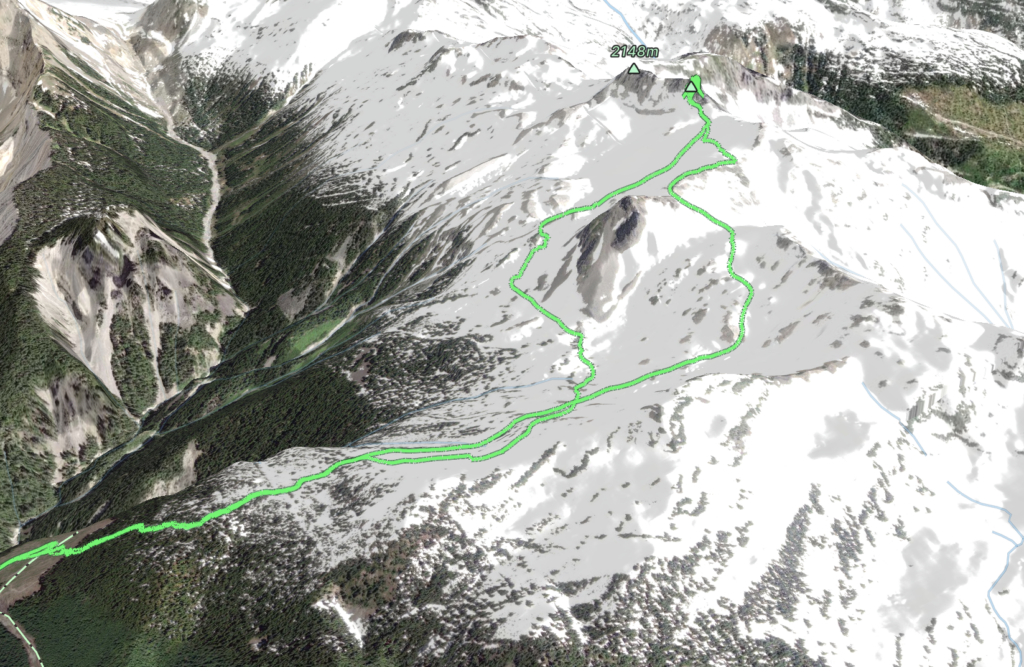
Elevation Gain: 1,353 m
Distance: 18.21km
Total Time: 12 hours 18 minutes
Date: March 31st, 2024
Mount Fee can be aptly described as a a twin set of “evil volcanic blades” rising high above the west side of the Brandywine area. The peak is comprised of two towers, both with their own unique character. The north tower is the lower of the two and can be done as a steep and exposed snow climb or a loose 4th class scramble. For these reasons it sees ascents every few years and has even been skied off. Although, it’s not to be underestimated. The south tower appears to see far fewer visitors as the easiest route requires exposed 5.6 climbing on loose volcanic rock and does not hold enough snow to bypass the technical climbing. Both summits have a reputation for dangerously loose rock and as such are best done with a deep snow pack to cover their lower flanks.
The south tower was first climbed by Bob Woodsworth, Mike Wisnicki and Peter Thompson in May of 1963. Since then, at least one other route has been established on the north side by Kobus Barnard, also at 5.6. Bruce Fairley has a short description about the first ascent route in his guidebook and Kobus Barnard describes his route has exceptionally loose. However, that’s about as much detail as you can find online and photos of the upper route seem nonexistent. Naturally, this had a big appeal for me when I saw mention of it on Steven’s report of the north tower. Fast forward 2 years later and myself Alex and Andrea found ourselves halfway to Mount Fee for a first attempt on the summit. We didn’t even bother going to the base when we spotted a massive crown bifurcating the upper face and uncertainty about snow stability came into play. It was a big defeat hauling up 40+ lbs of gear each and to see the ridge in perfect dry condition.
So, it’s perhaps no surprise that I would attempt it again a week later when a narrow window of opportunity opened up over the long weekend. Alex would be joining me again, but with Andrea away in Smith Rock, Alessandro answered the call for a third spot. Instead of hauling gear all the way up to the base and camping we opted to drive the night before to the top of Shovelnose Creek FSR and car camp with an alpine start. We’d be threading the needle a bit as the avalanche forecast called for considerable in the alpine due to a rapidly rising freezing level as the sun hit. From our attempt the weekend before we knew that sun would hit Fee’s slopes around 11:30am. If we could get there for 7am roughly, we should have enough time. Based on photos, I estimated 3 pitches to gain the summit. One to reach the ridge, a second to traverse it, and a final pitch to gain the summit block.
There was one sting in the tail though. It had been snowing throughout the week and there was supposedly up to 30cm of new snow. That bone dry ridge we had spotted the week before was likely no more, but we’d have to figure it out on site.
On Saturday evening, Alessandro drove us to the snowline at 800m and we set up camp with alarms for 2:30am. The following morning we hit the snow covered remainder of the FSR by 3:05am and made fast time up to the last cut block. As we climbed higher the new snow grew progressively deeper and by the time we exited the forest it was heavy trail breaking in the snow shoes. Thankfully, some snow mobile tracks here and there gave some reprieve before we broke off on our own to contour around the north side of “Shovelnose Peak”. After a heavy trail breaking session we reached the base of Fee just in time for sunrise.
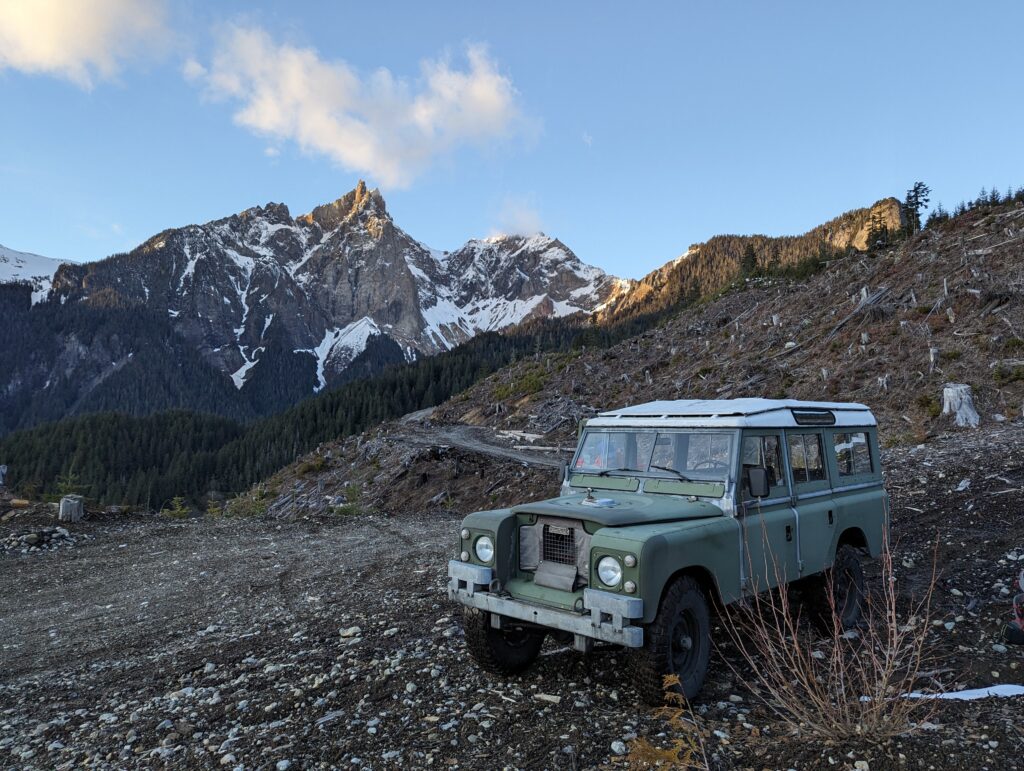
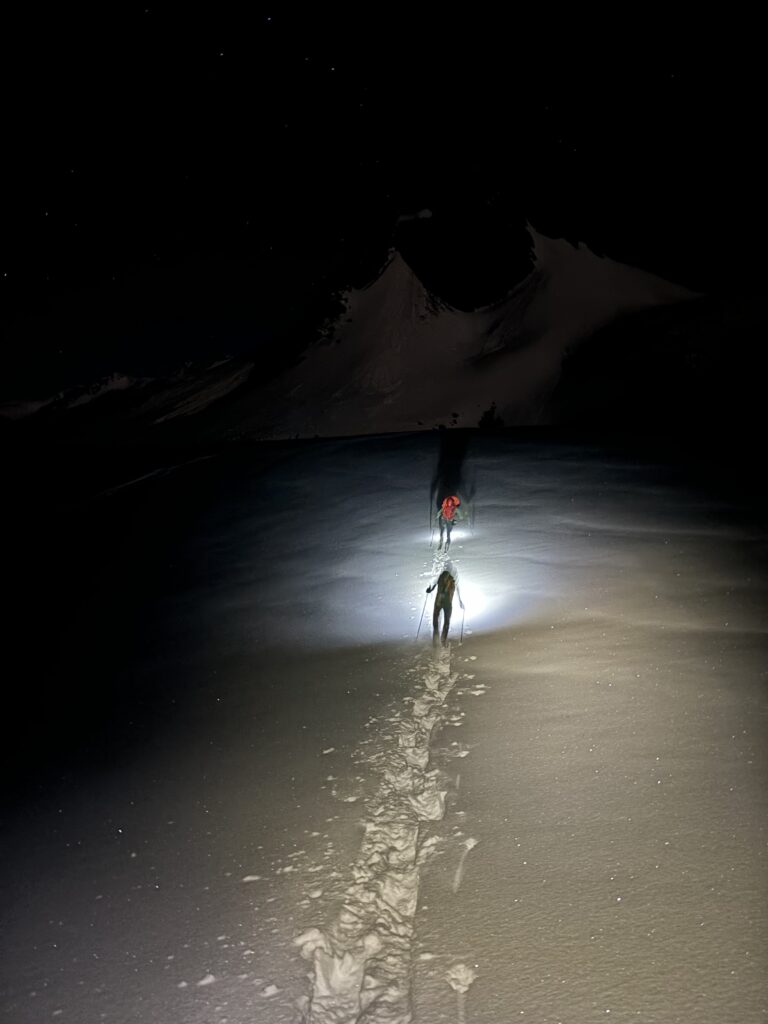
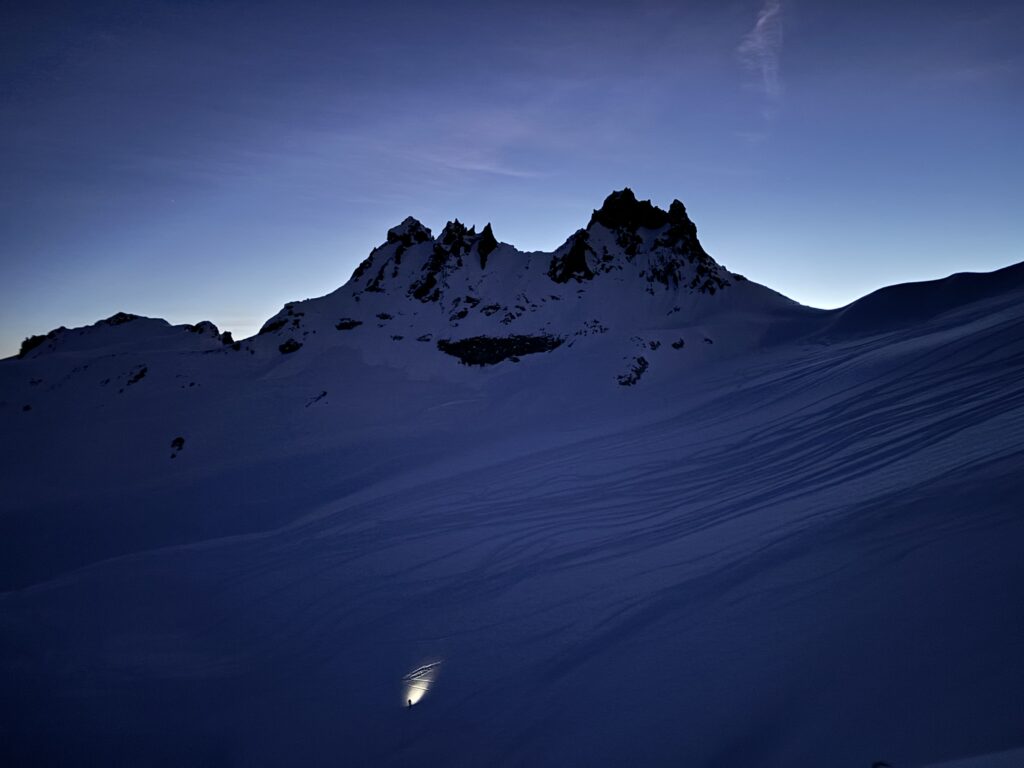
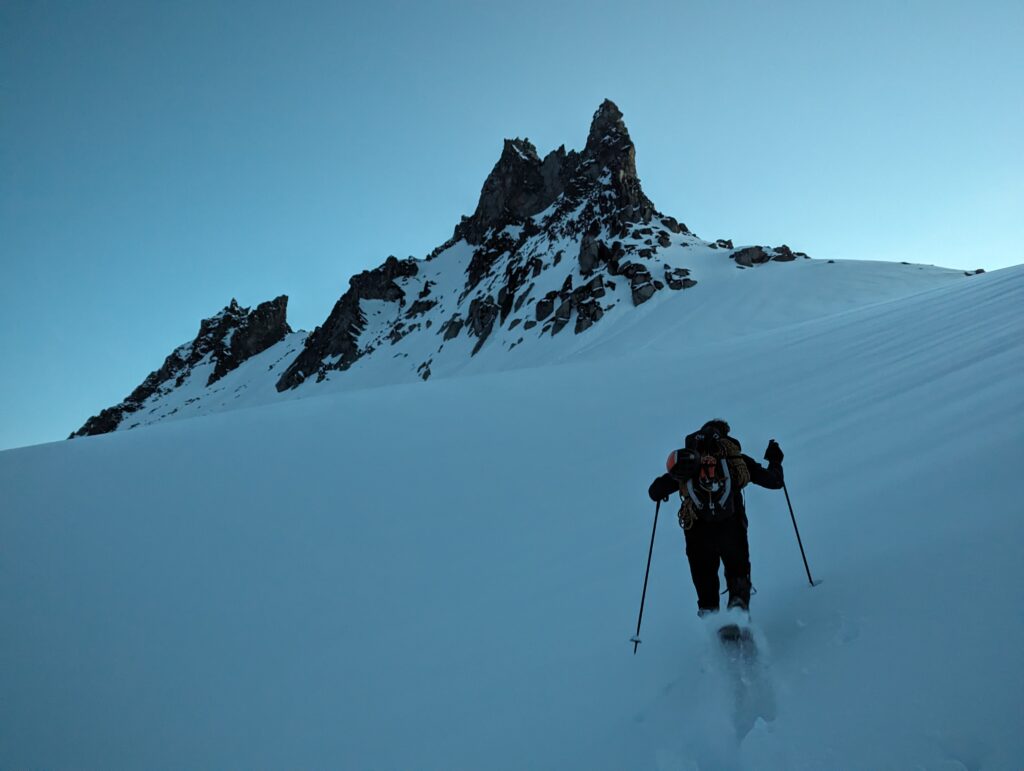
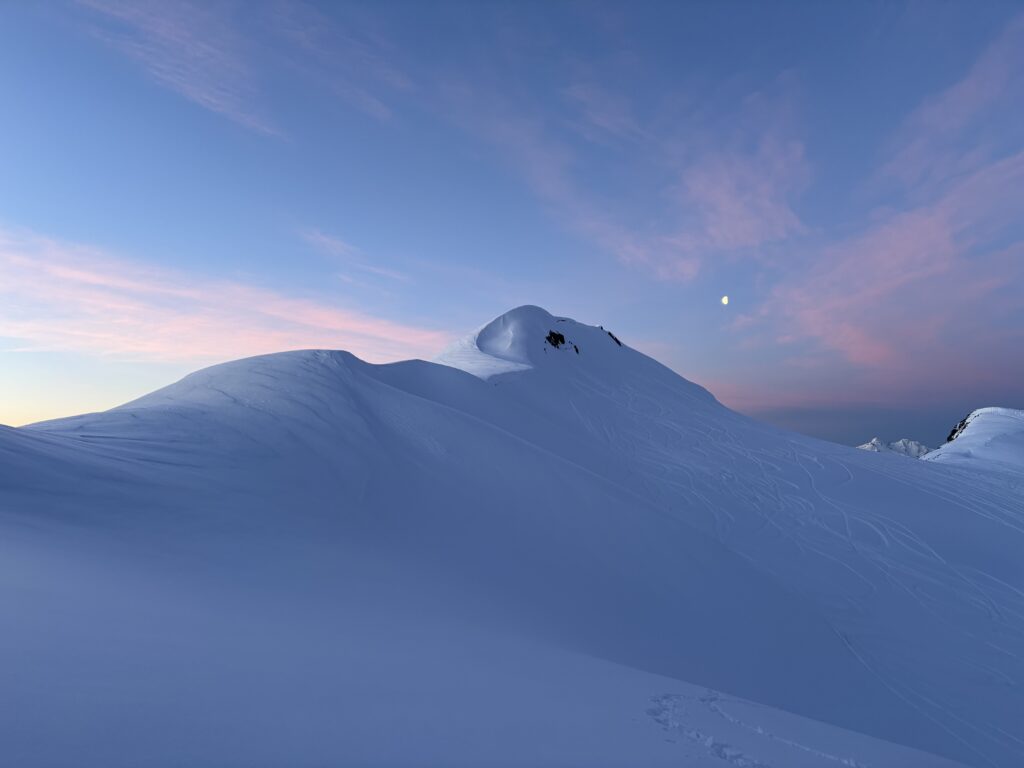
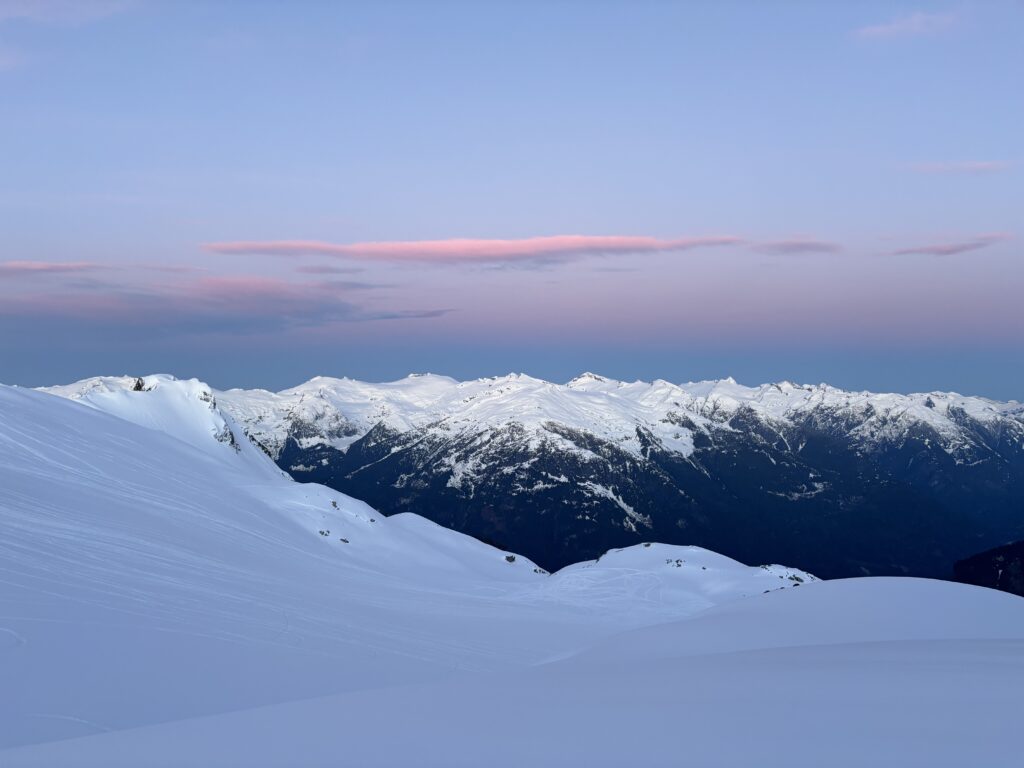
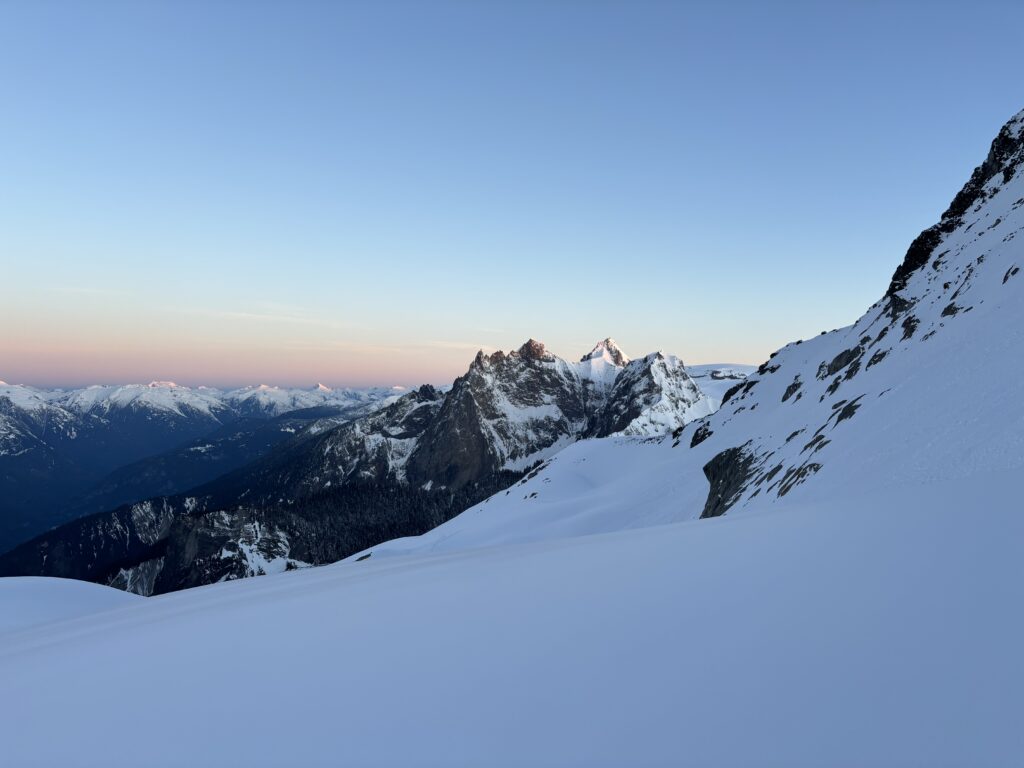
We stashed some gear and then Alessandro and Alex lead a wallowing traverse across the slope through old wet loose debris. They were aiming for a narrow section in the massive avalanche crown from two weeks prior. Just below the crown I took over the lead and pulled up and over it and onto a runnel above. I then traversed climber’s right to regain the narrow constriction of snow to access the upper snow slopes. The conditions were quite firm and there was solid purchase the crampons and tools, so we made good time to the base of the first pitch below the ridge. I don’t think the snow ever exceeded 45 degrees, but better judges of inclination will have gauge for themselves.
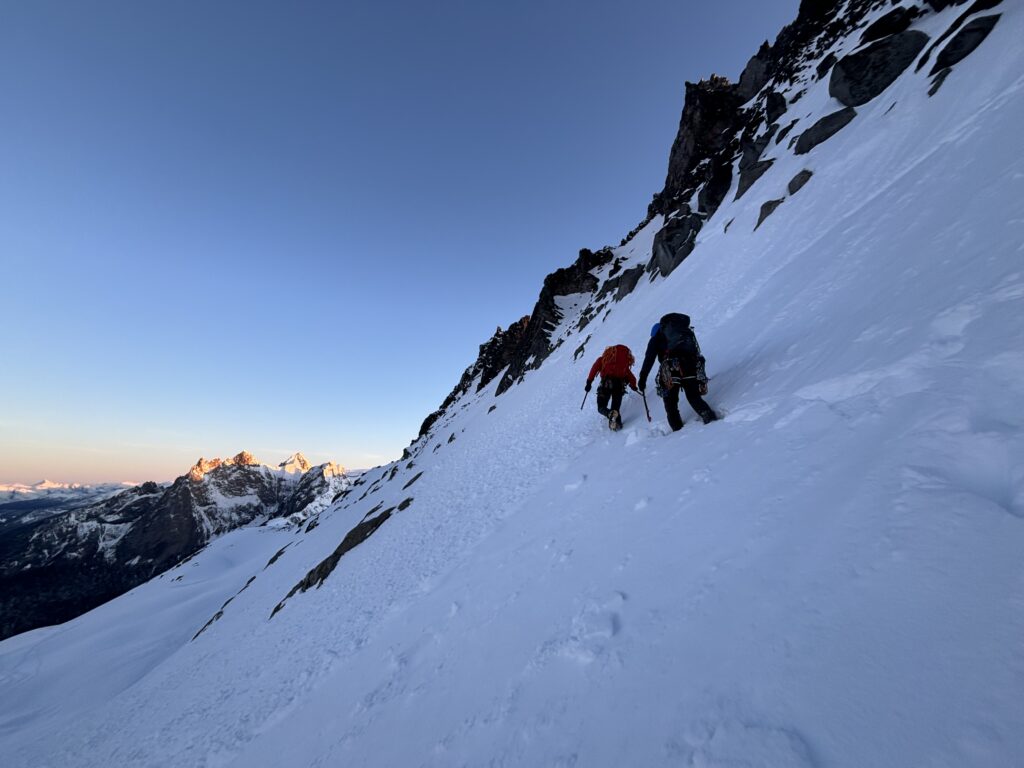
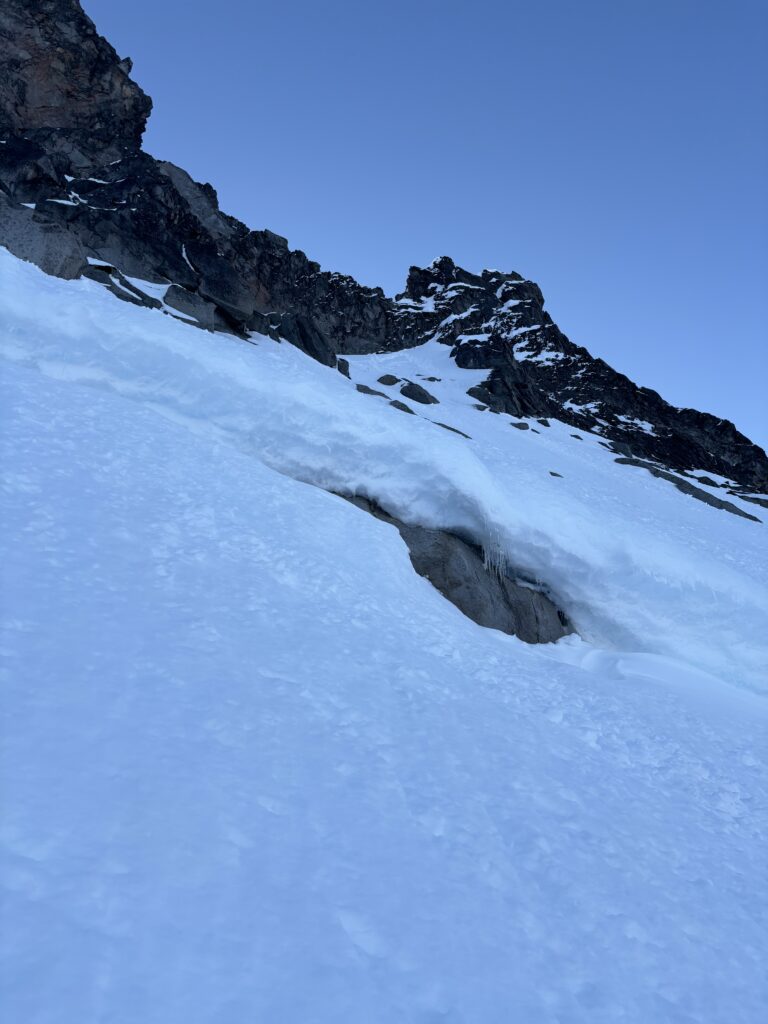
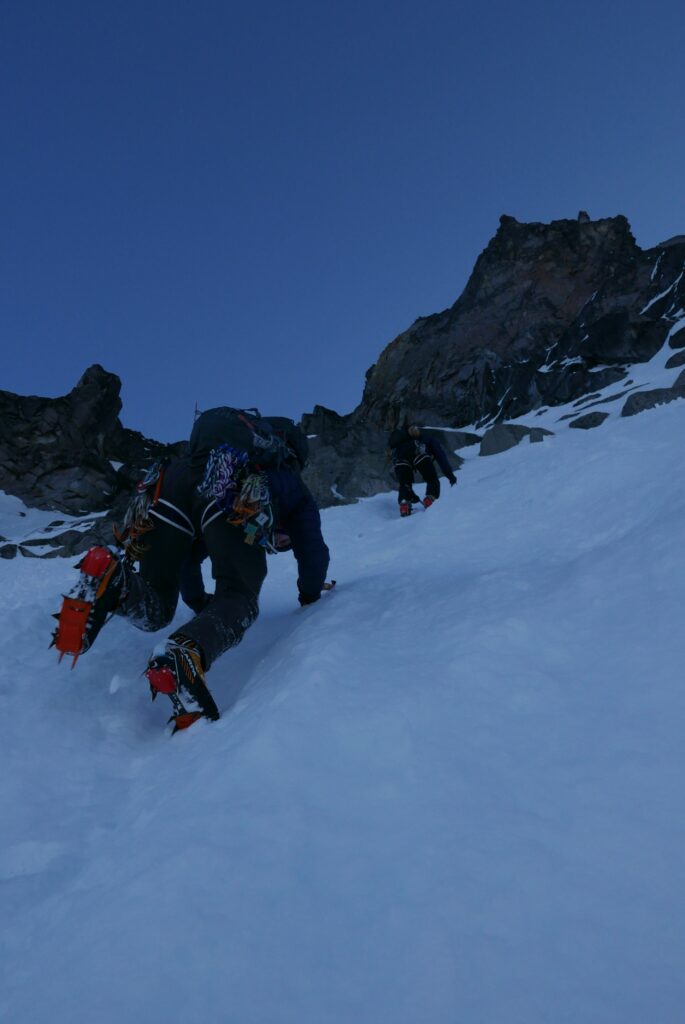
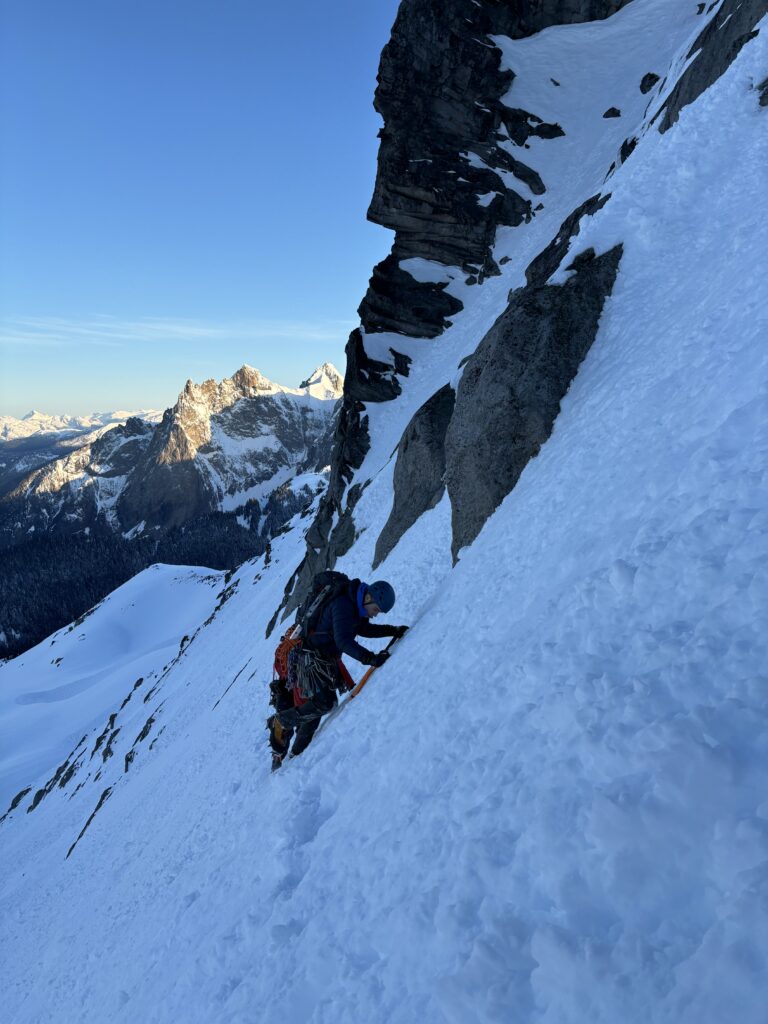
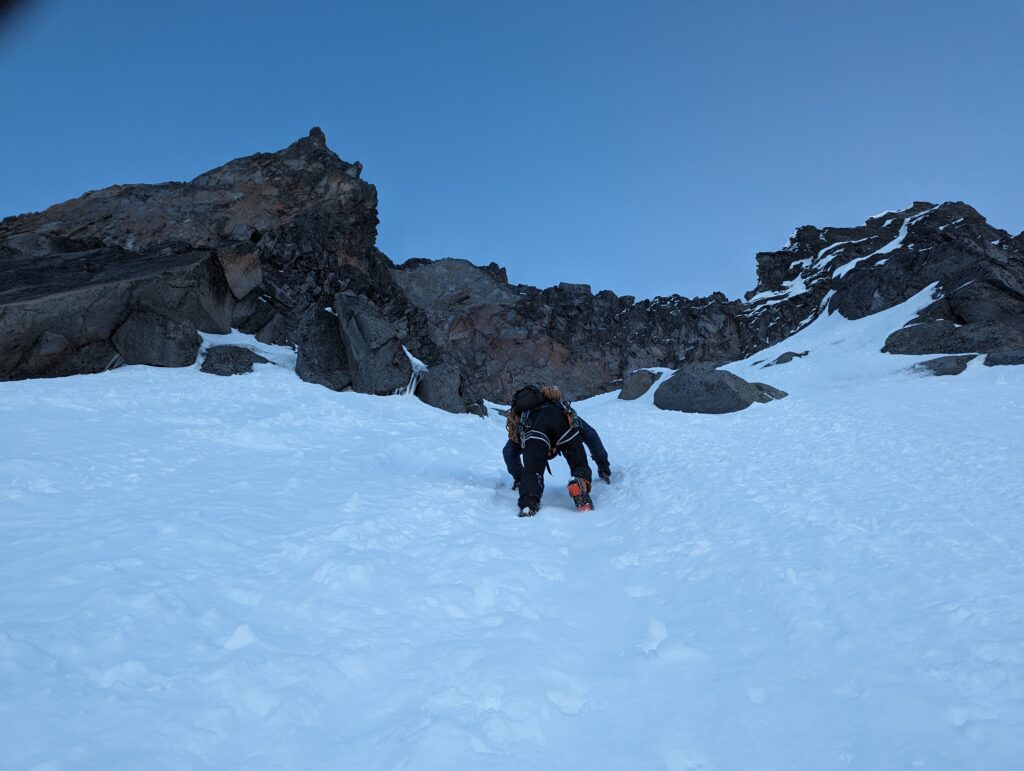
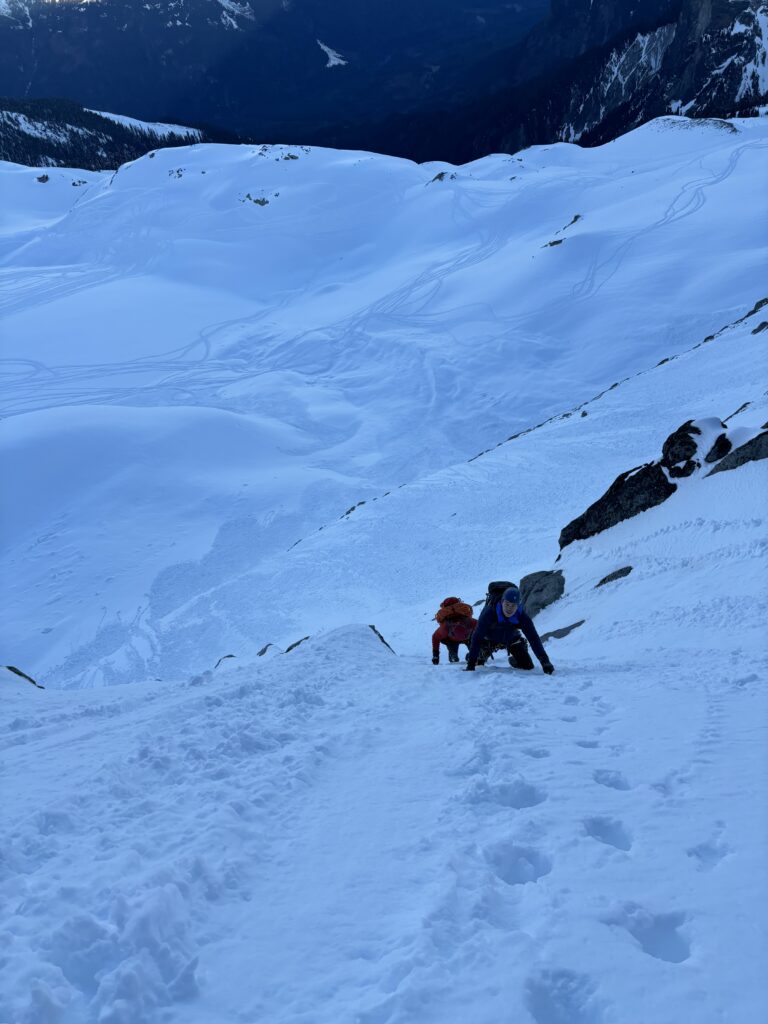
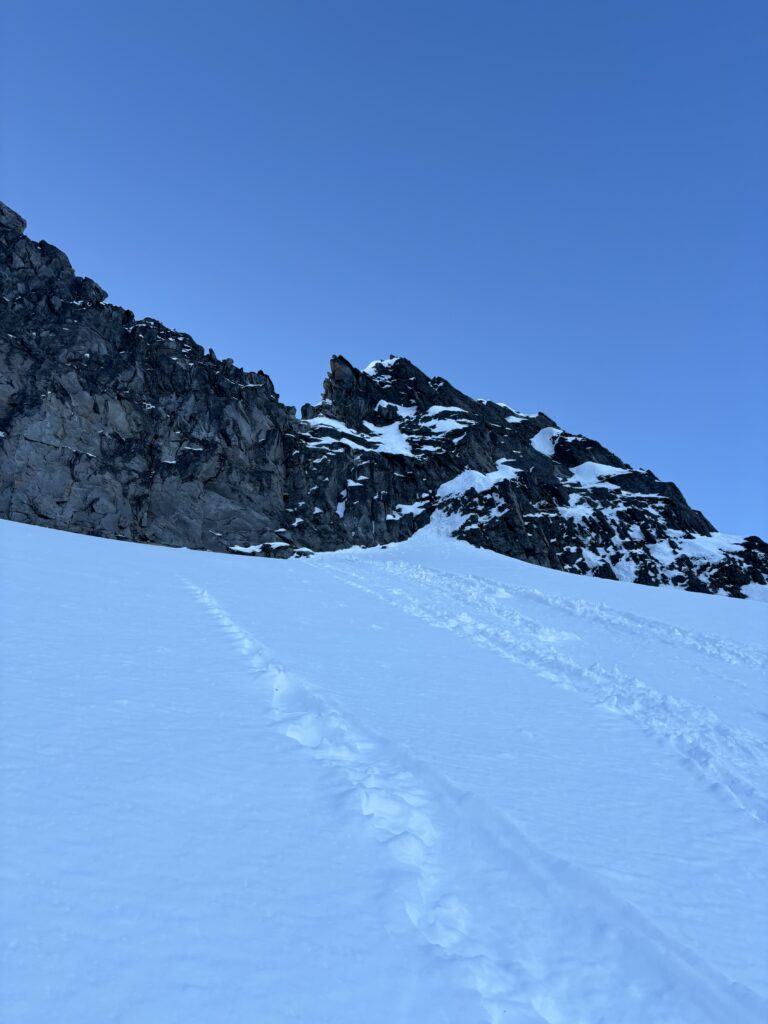
Alex was already racked up with the cams, so he took the first pitch to gain the ridge. The conditions on the west side were indeed quite snowy and the route was looking more like a mixed climb than a rock climb. Alex had to traverse a ways out climber’s right before finding a spot to gain the rock and then lead up the steep snowy wall. Rocks were frequently showering down as Alex dispatched with the many loose pieces clinging on to the wall. Just below the ridge, the wall blanked out and he had to lower a bit to gain better holds before topping out on the ridge.
Now came the issue of finding a suitable anchor. As it turned out the ridge was a knife edge and there simply weren’t any to be found. Eventually he settled on a precarious detached section of ridge that had an old bail sling on it. I followed up second, armed with two ice tools, and found the climbing quite tricky in these conditions. A solid lead from Alex to say the least! There wasn’t enough room for me at the belay station so I climbed above Alex and moved into an au cheval spot on the ridge. Alessandro started up next and I began the awkward dance of swapping crampons on and boots for climbing shoes.
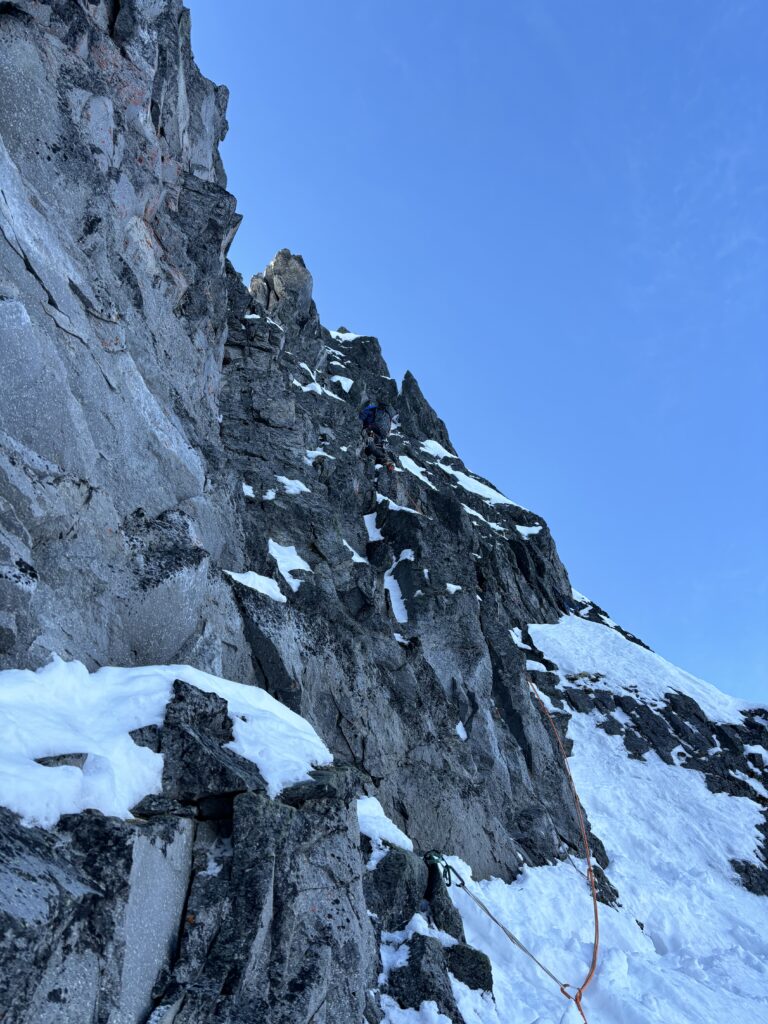
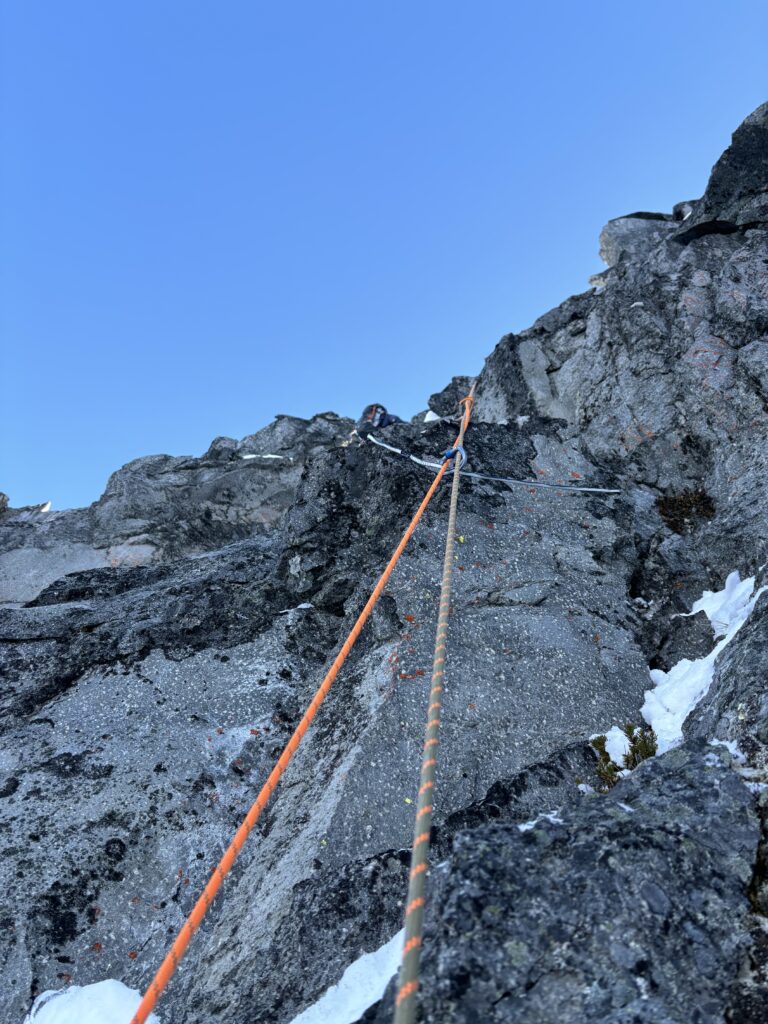
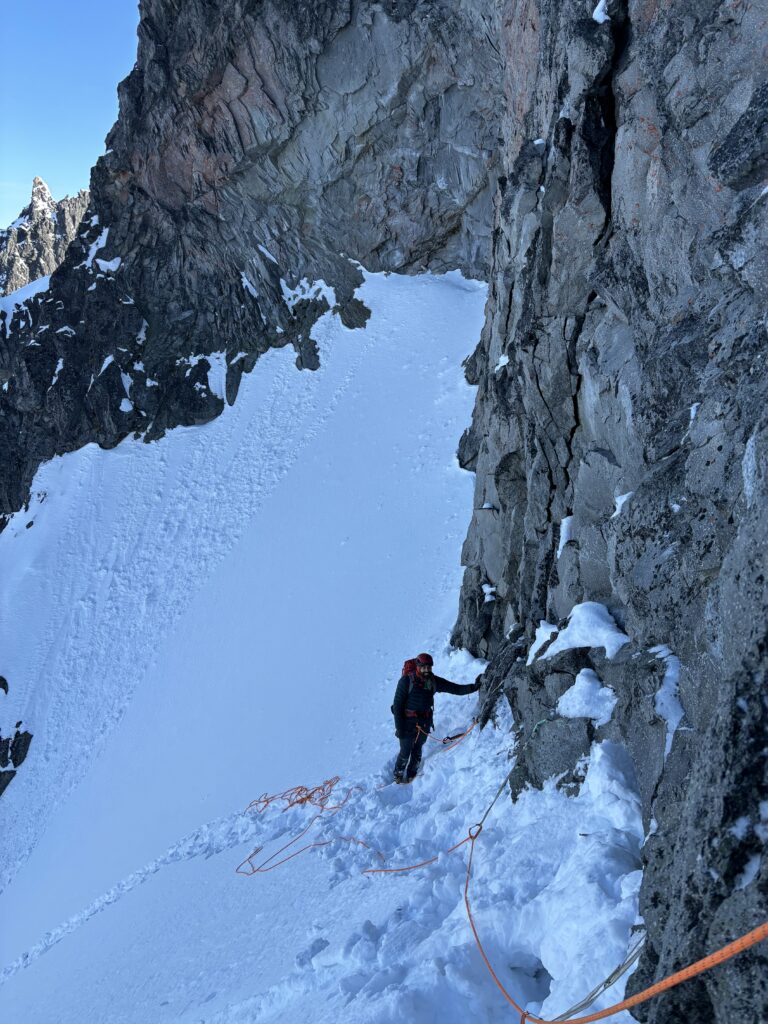
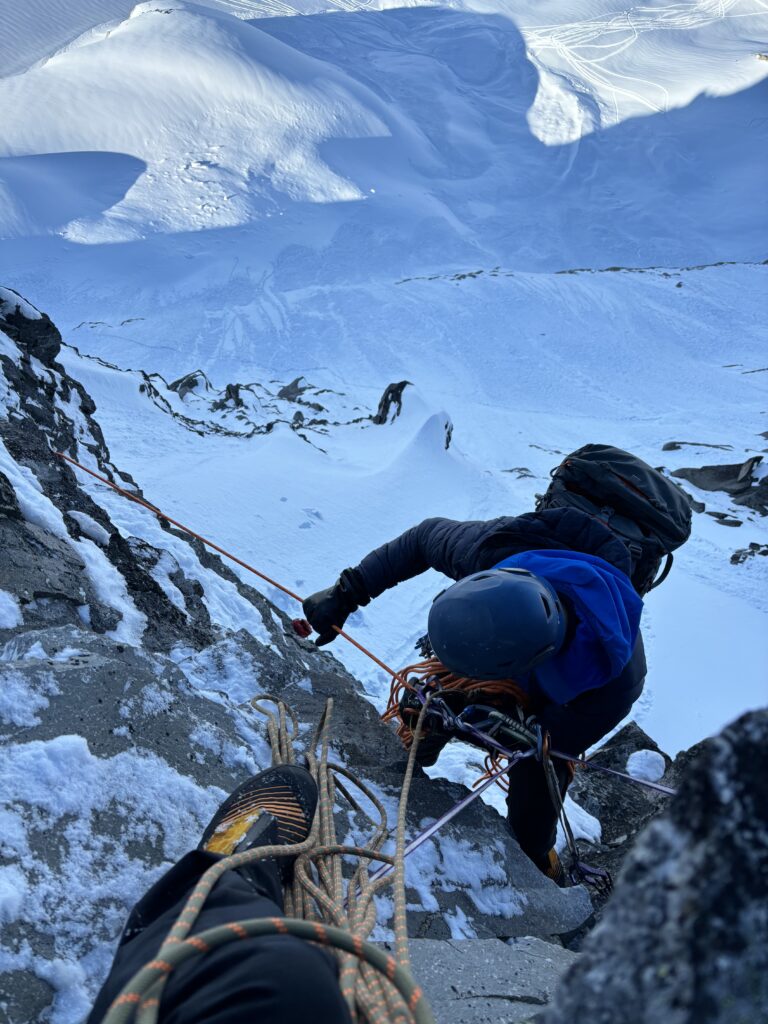
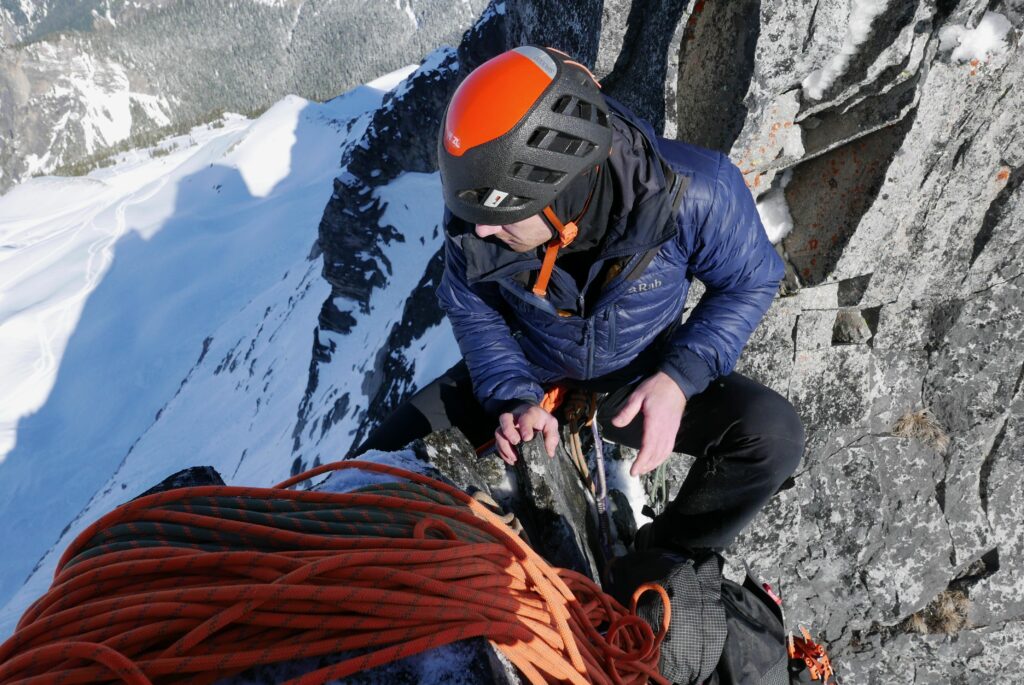
Once Alessandro was setup in his own au cheval spot, he put me on belay and I started the ridge traverse. The first order of business was scooting across the knife edge section of ridge that was covered in 6″ of snow. Inevitably my climbing shoes got soaked and their grip went out the window. After the “snow cheval” the first half of the ridge was characterized by loose blocks, kitty litter hand holds, exposed steps and snow where you didn’t want it. Nonetheless the grade never exceeded 5.6 and I managed to pick a reasonable line through. Finally, I had to step onto the west side to bypass a gendarme. There were several exposed steps and snow covered hand holds to work with. A single fixed piton offered a sign that I was at least on the right track. After the bypass, a final steep gendarme guarded the last bit of ridge. A loose chimney offered the only reasonable way up and it took a few tricky moves to avoid the plethora of loose blocks.
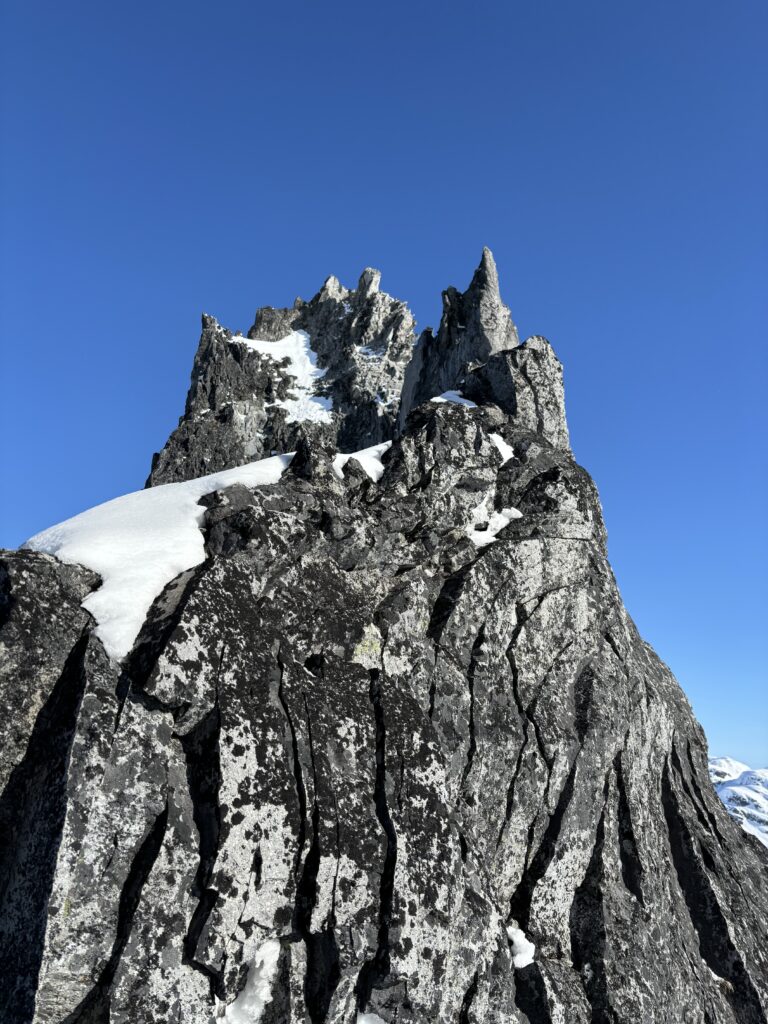
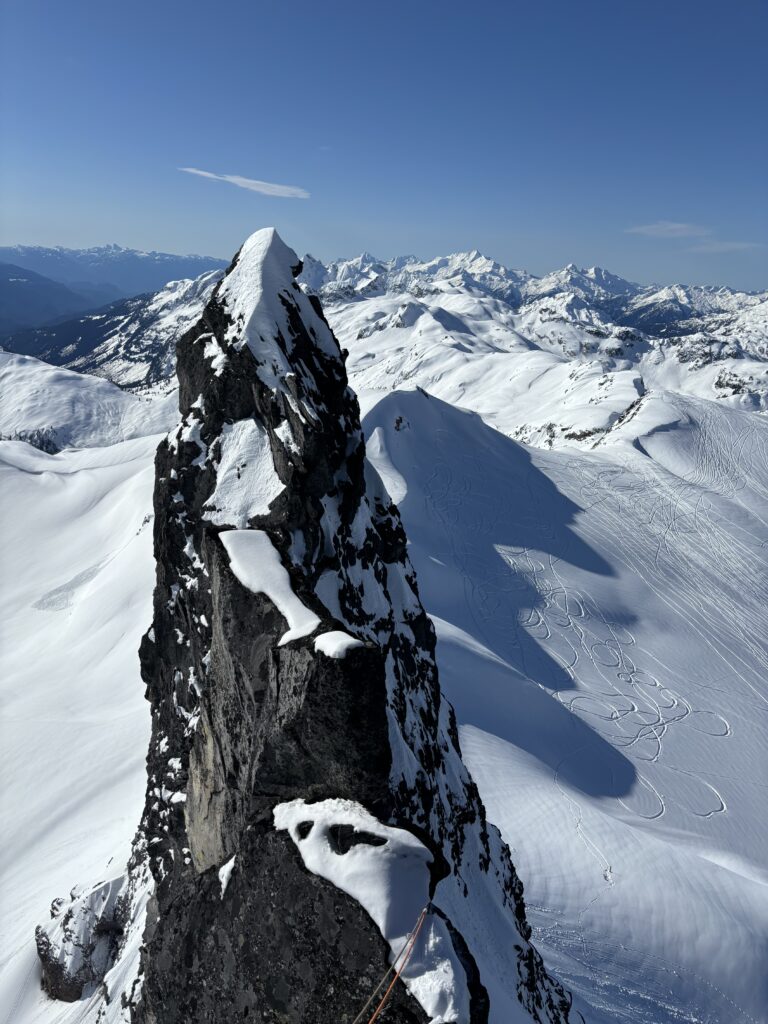
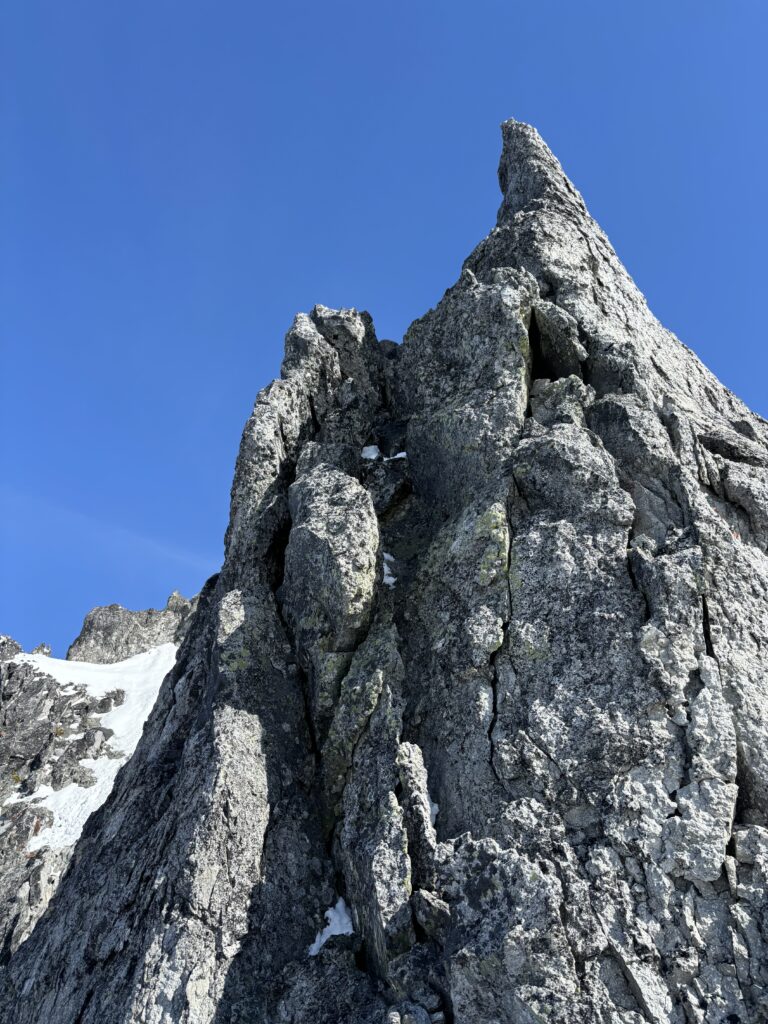
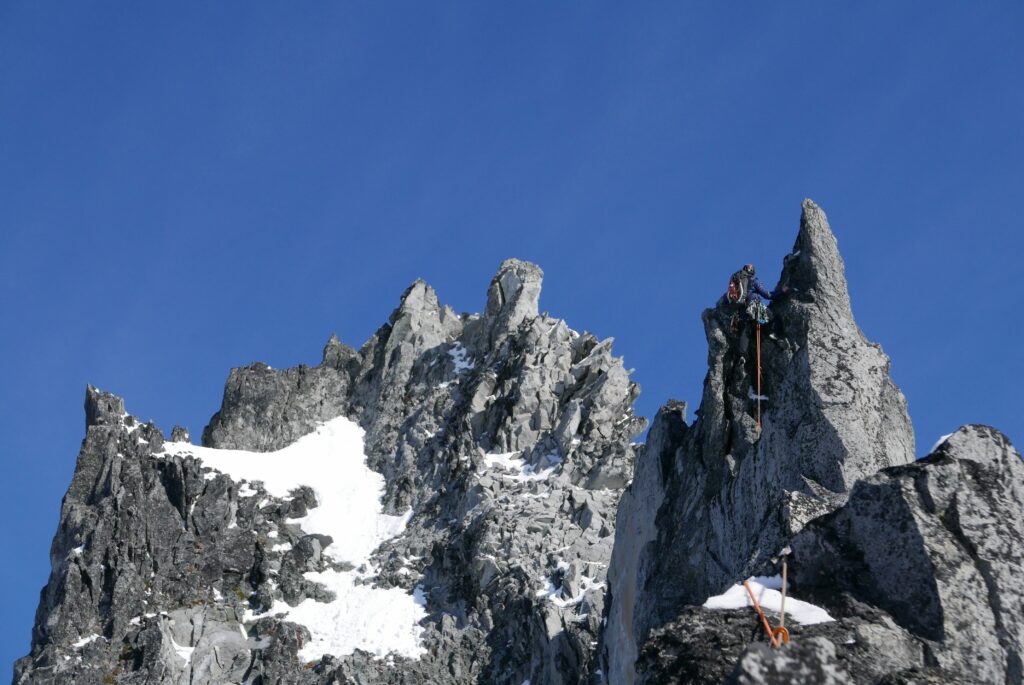
Thankfully at the top of this gendarme I located a nice standing platform with a solid-ish block to sling and that ended my lead. Looking back, I had found about 7 pieces of protection along the ridge, but I would say most were ornamental and perhaps 2 of them I’d consider taking a fall on. Alex seconded up next and then Alessandro.
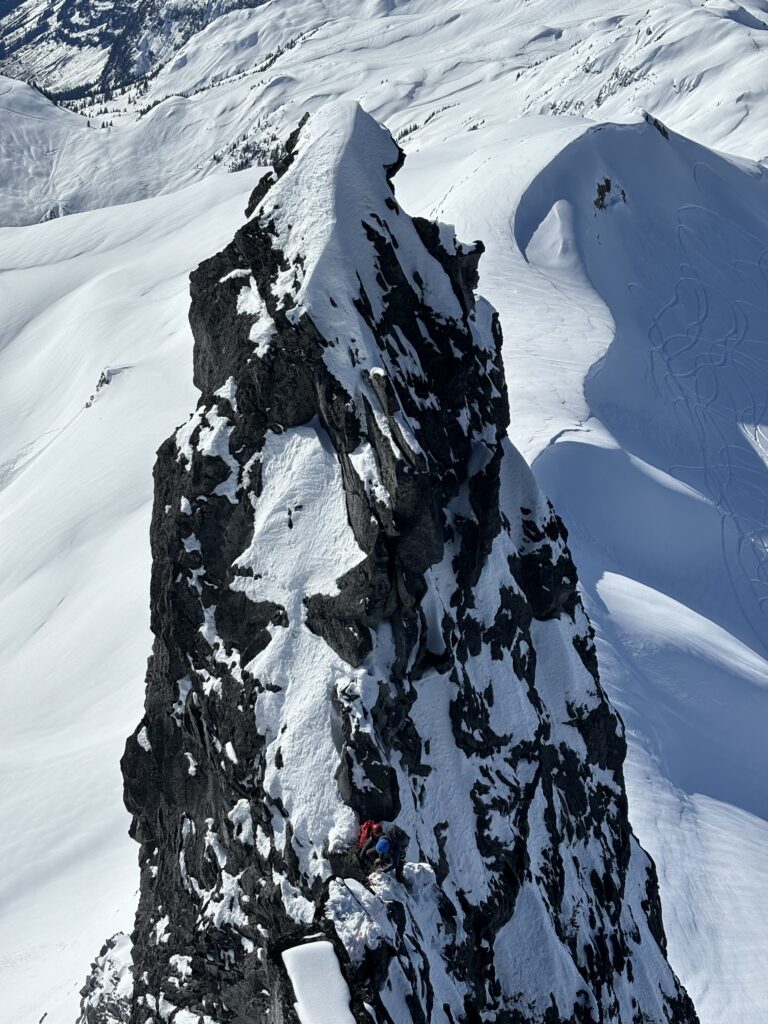
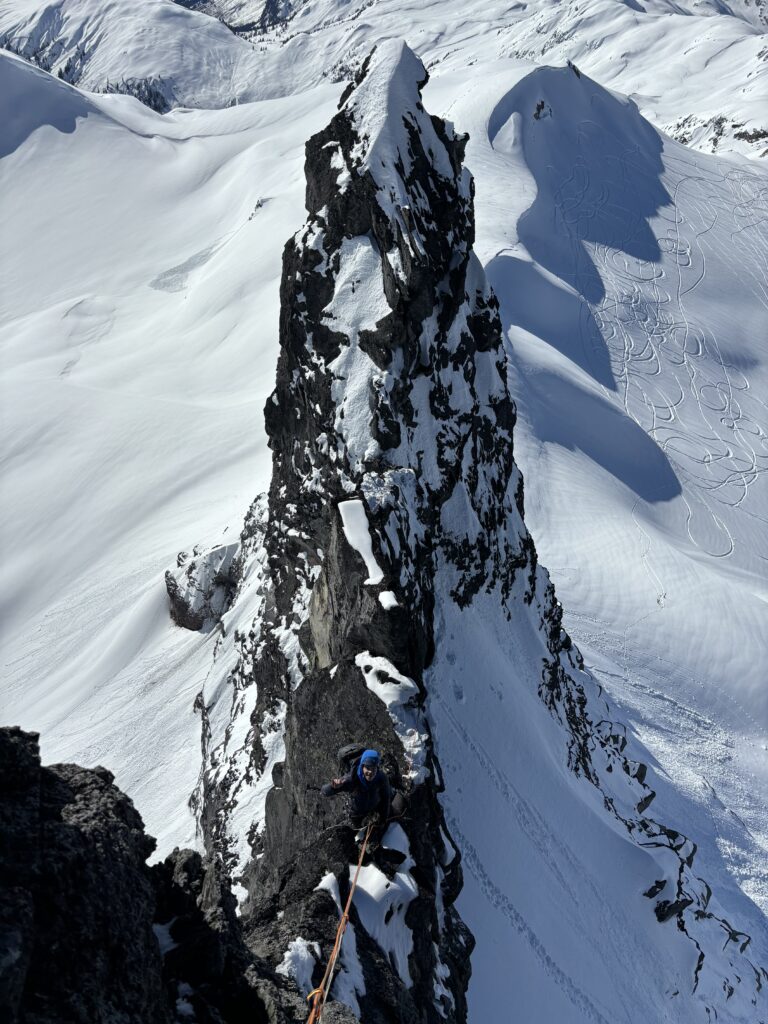
Now, it was Alessandro’s turn to take us to the top! He au chevaled and stepped through more snow covered ridge before gaining the upper summit face. To all of our surprises it proved to be the most solid section for rock despite its jumbled appearance. Alessandro cruised through the first part of the pitch and then had to kick off several sections of wall before finding more solid footing to exit the upper part out climber’s right. A few steps later and he stood on the summit.
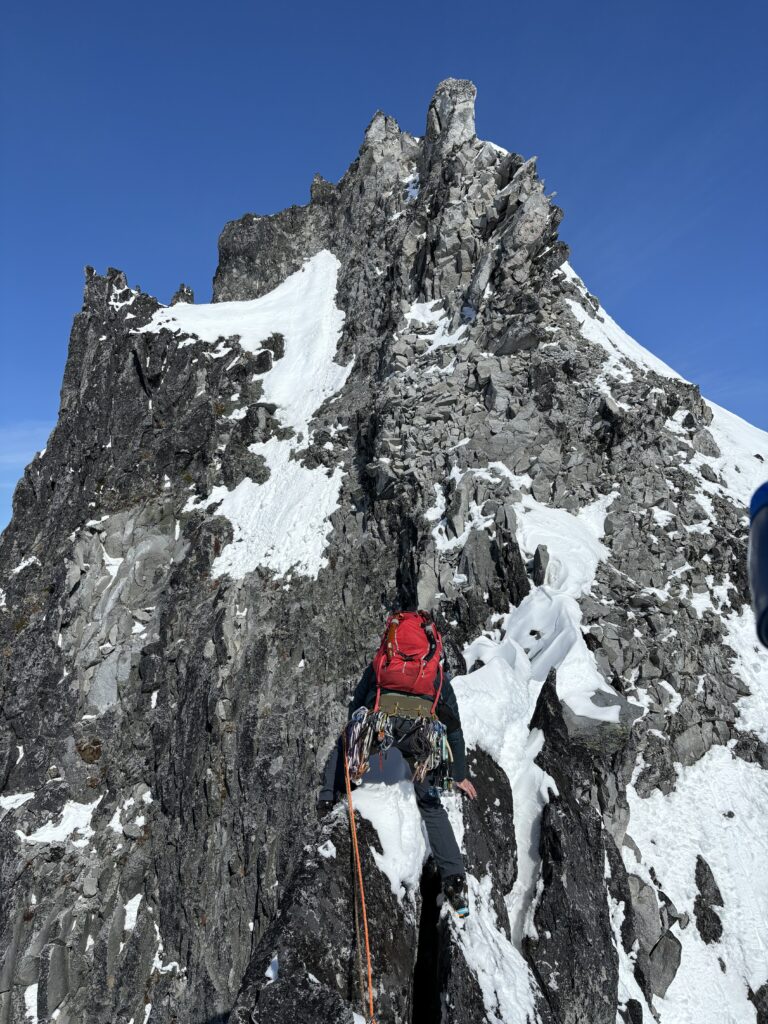
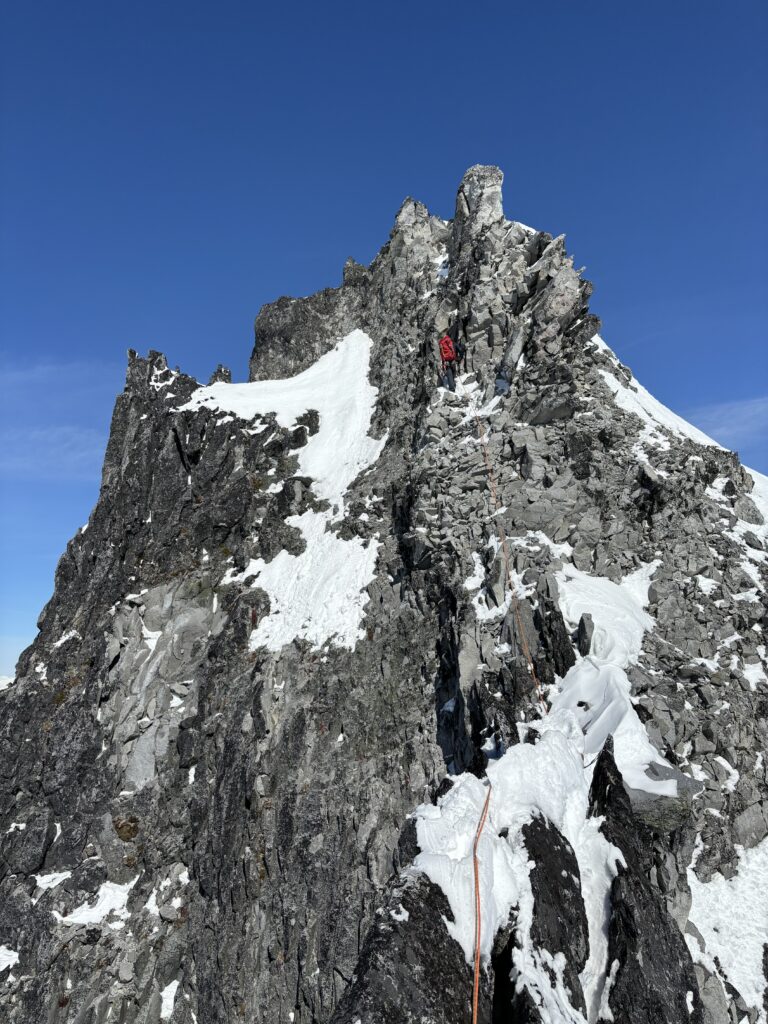
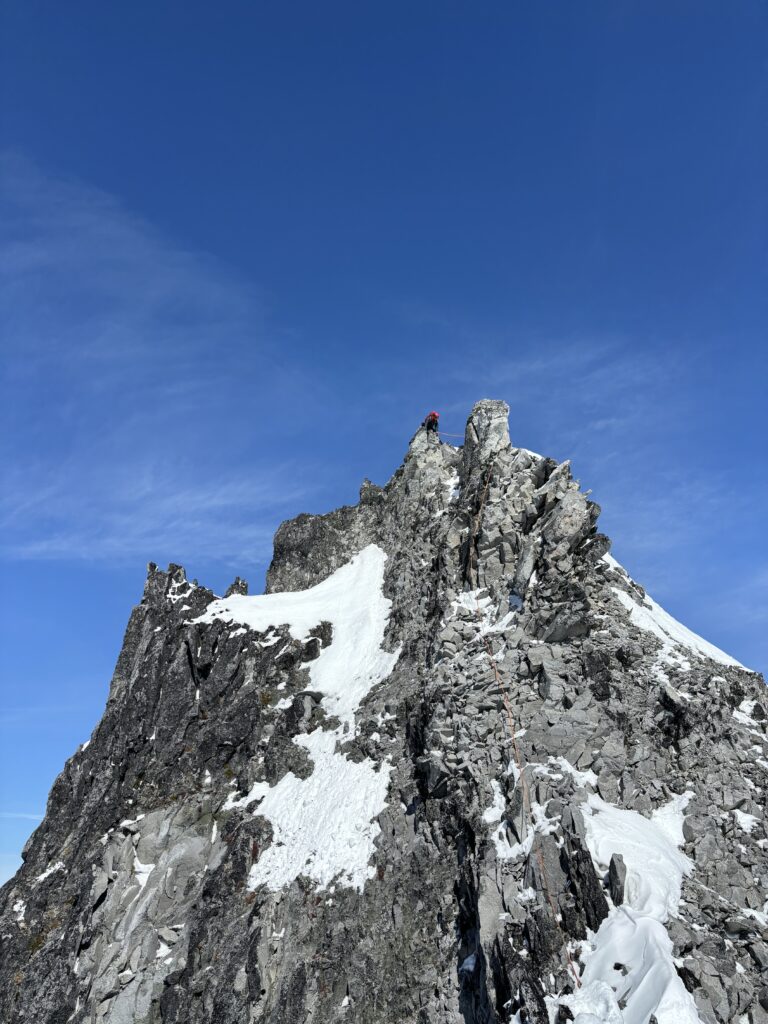
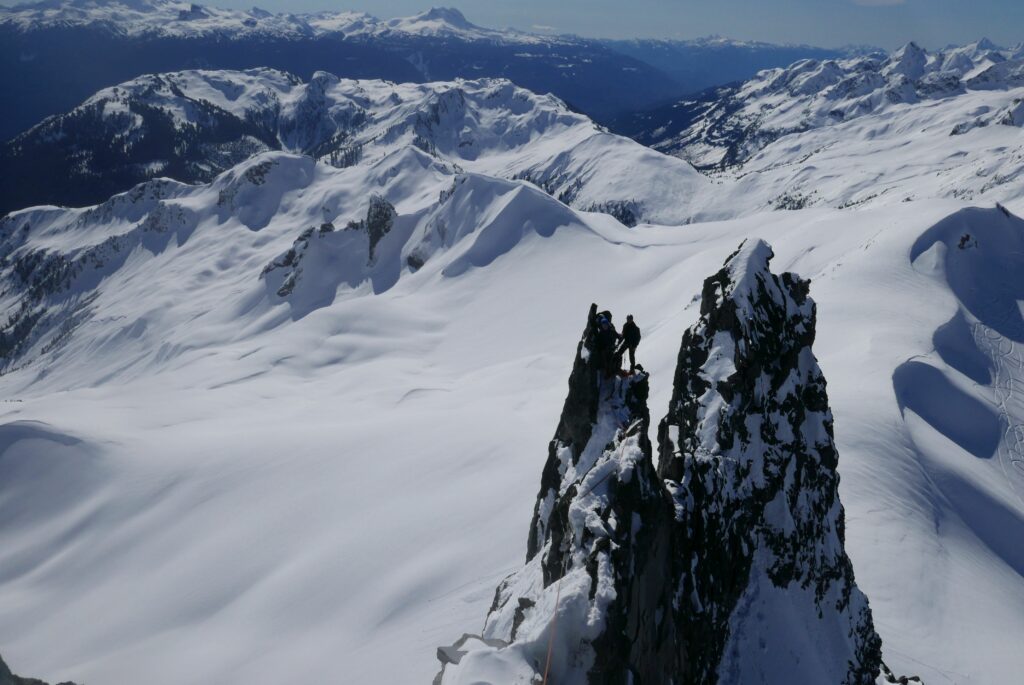
I had swapped back into boots while this was happening and started up next. The terrain was generally quite manageable, only steepening to just below vertical near the top. At the top of the rock section a final short snowy took landed me at the summit as well! Alex came up last, while Alessandro and I started to work out the descent plan. Notably, there weren’t any pre-slung blocks on the summit. Or if there were they were buried under a thin layer of snow. Evidence of ascents to the summit looked pretty minimal. All of the gear we had seen on the way up were used for retreats except for the fixed piton on the ridge, which was likely from the first ascent. Alessandro managed to sling one of the more solid blocks on the summit, although we all had a healthy mistrust for the rock at this point.
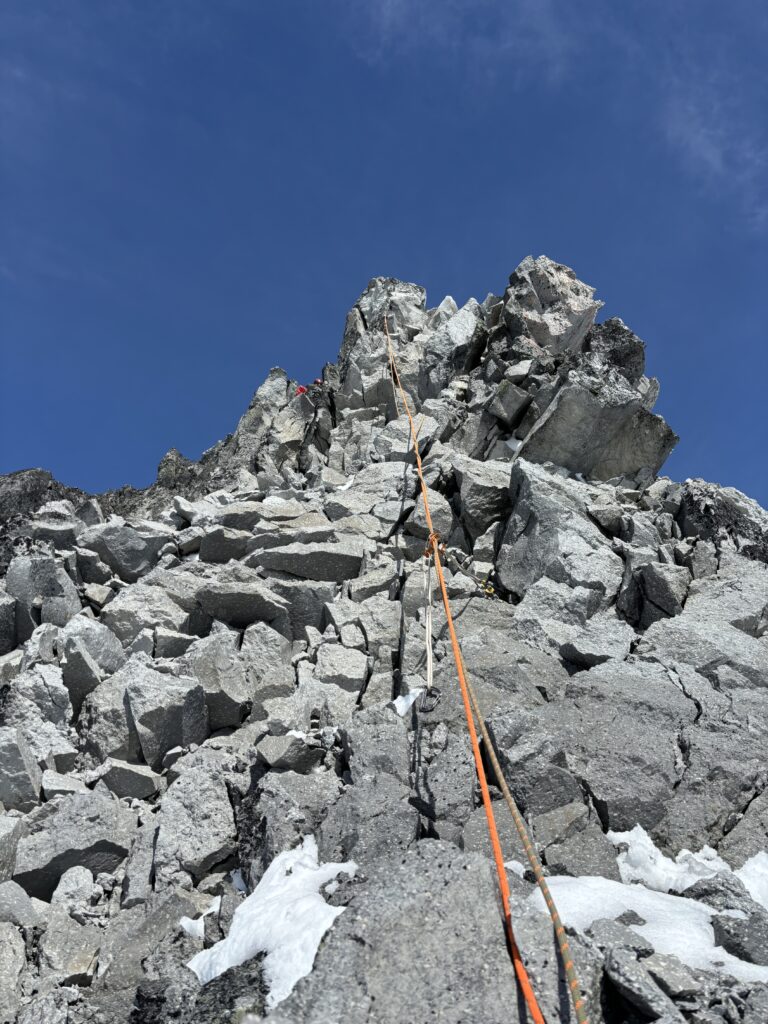
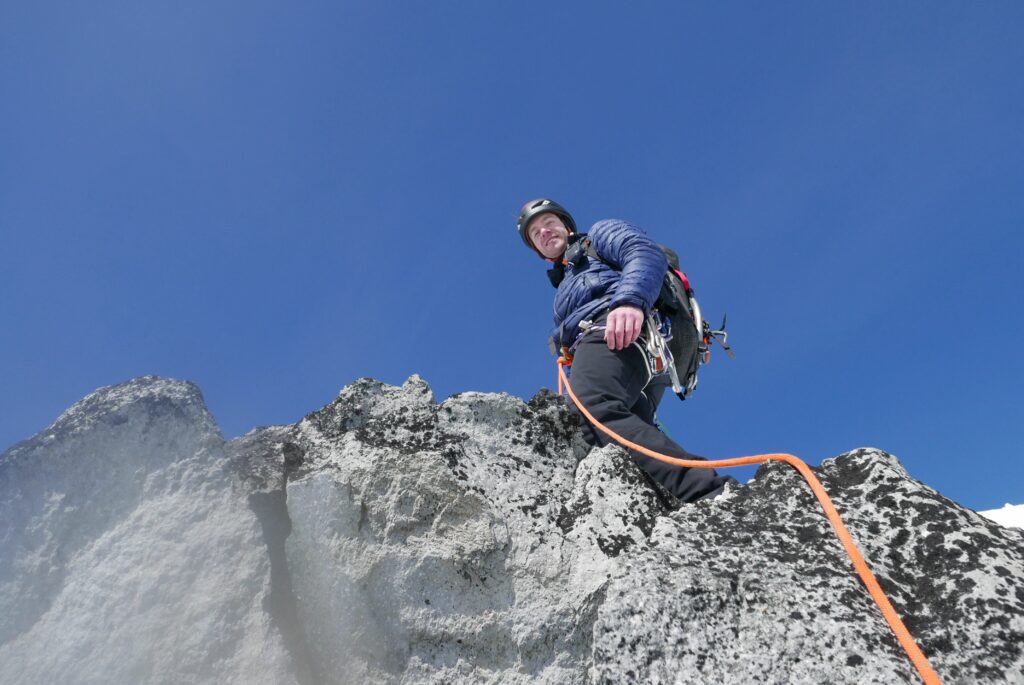
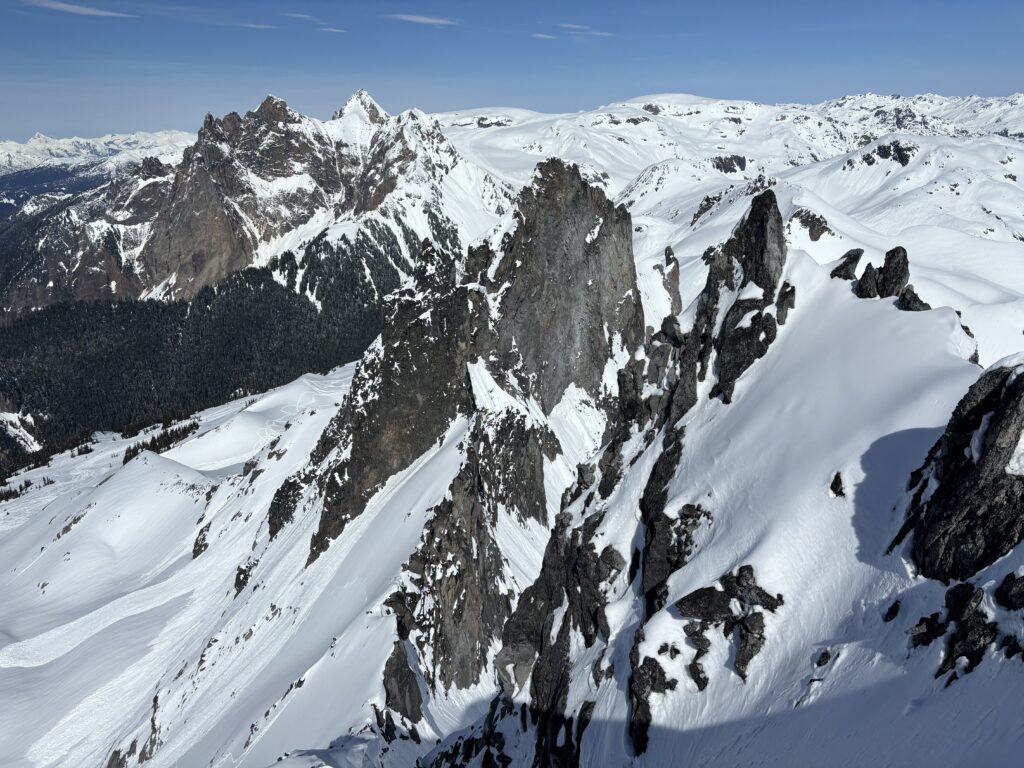
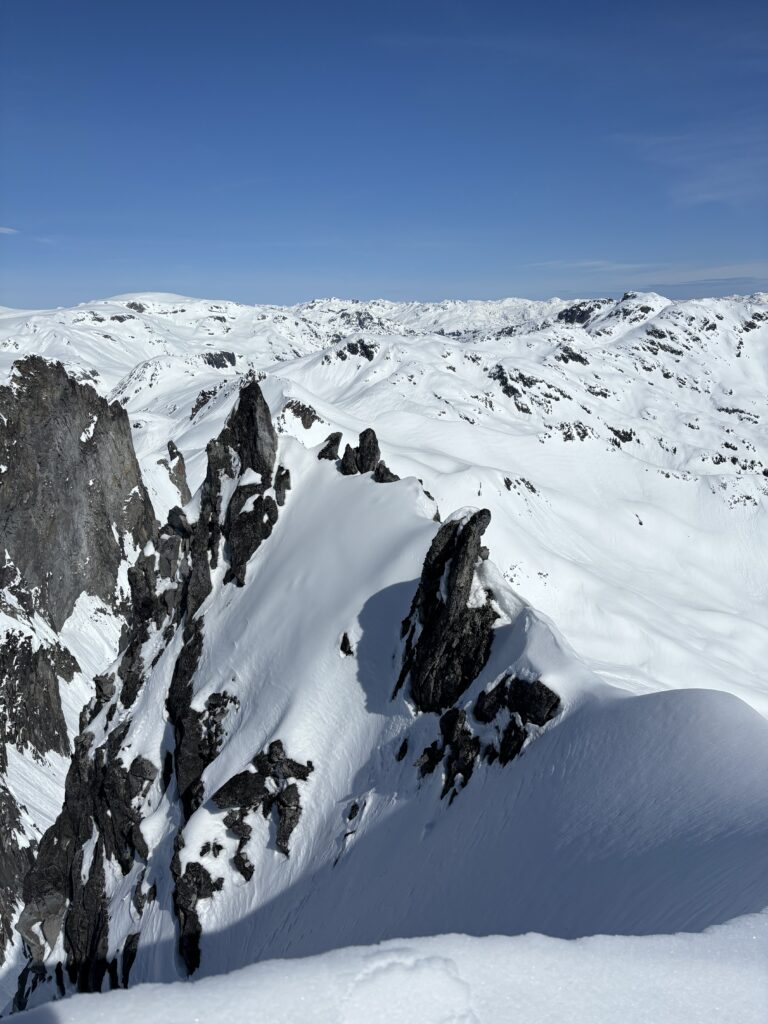
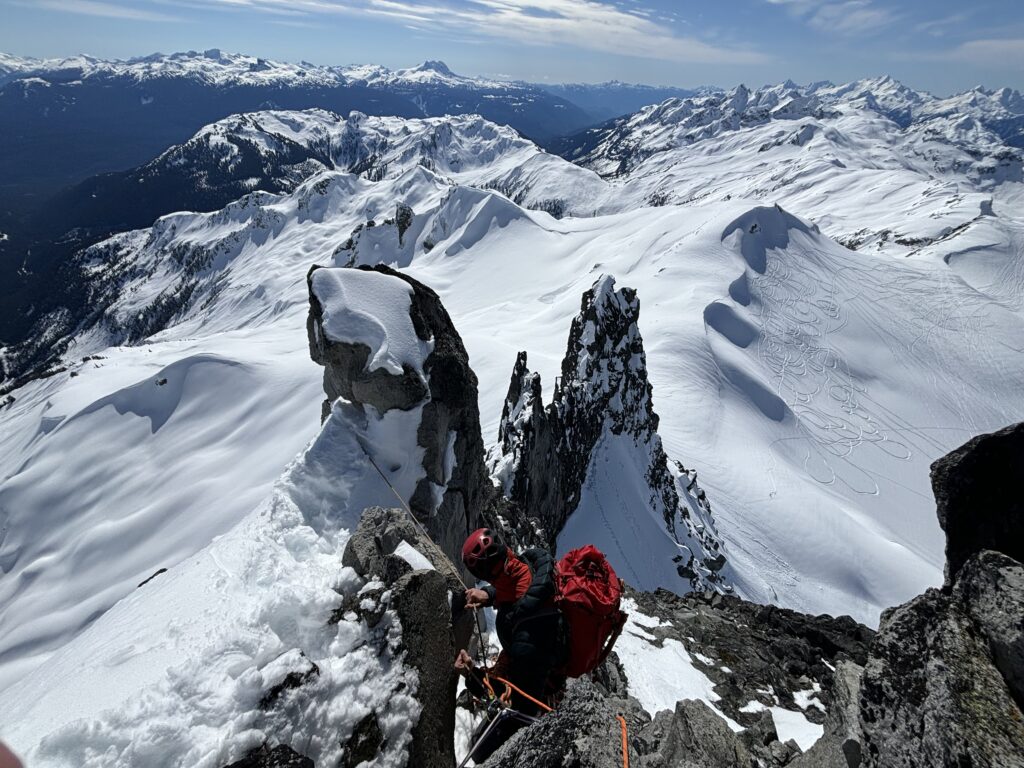
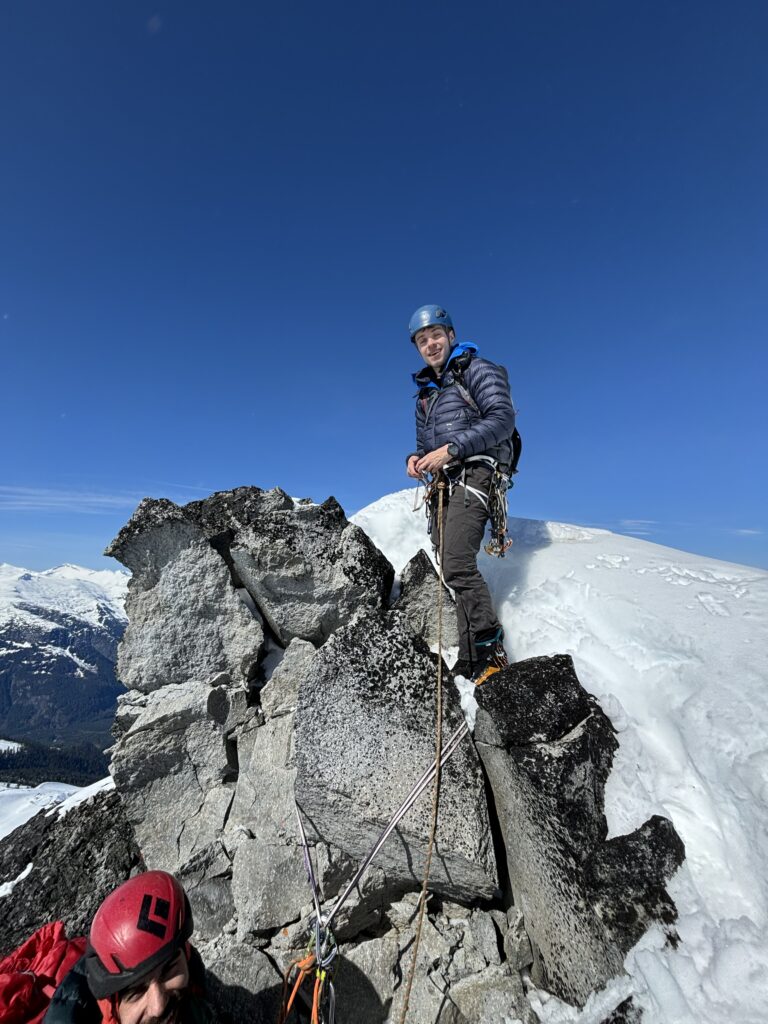
The sun was starting to hit our descent slopes, so time was of the essence. We had climbed with twin 60m ropes and so the hope was a single rappel would get us back to the upper snow bowl. Alessandro and I cast a strand out each, but they clumped into twisted piles on the numerous blades/slabs sticking out. Oh well, I rappelled down to the edge and after a few unceremonious tosses of the rope it was clear we’d make it to the snow in one go! A big reprieve. Once off rappel, I traversed back to our first belay anchor and started rigging another rappel station for us. Alex and Alessandro came next and we rappelled down the icy runnel/constriction we had ascended. We thought it might be worth doing one more rappel to get over the crown, but the snow still felt solid and so we opted to just down climb instead and save some time.
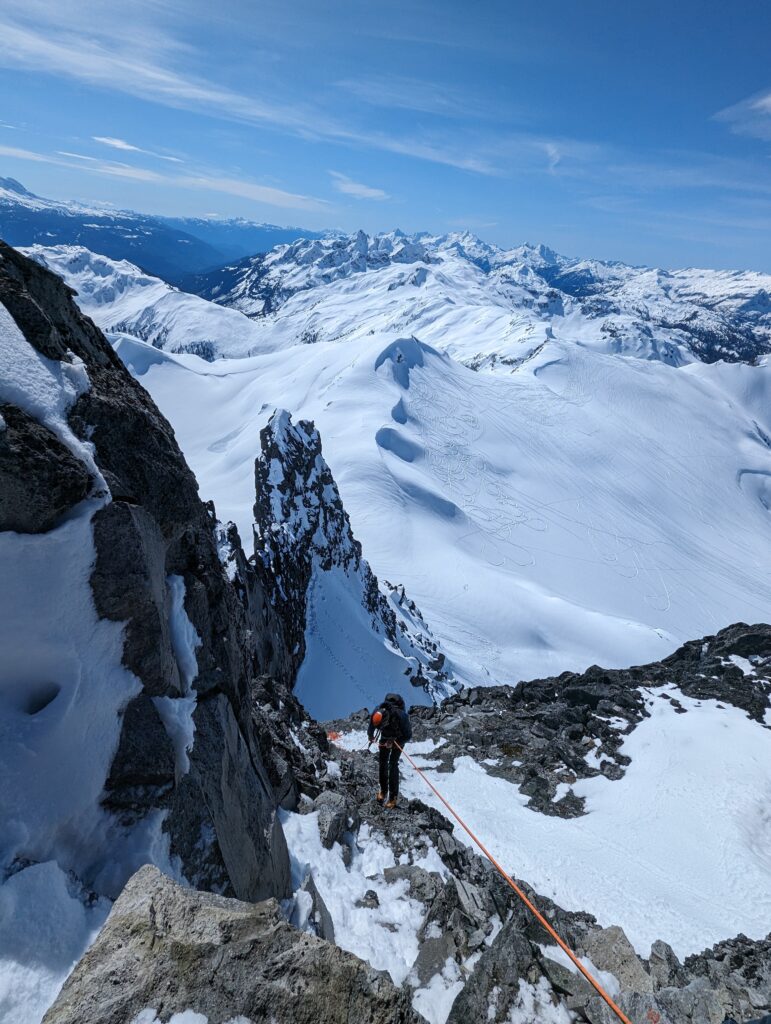
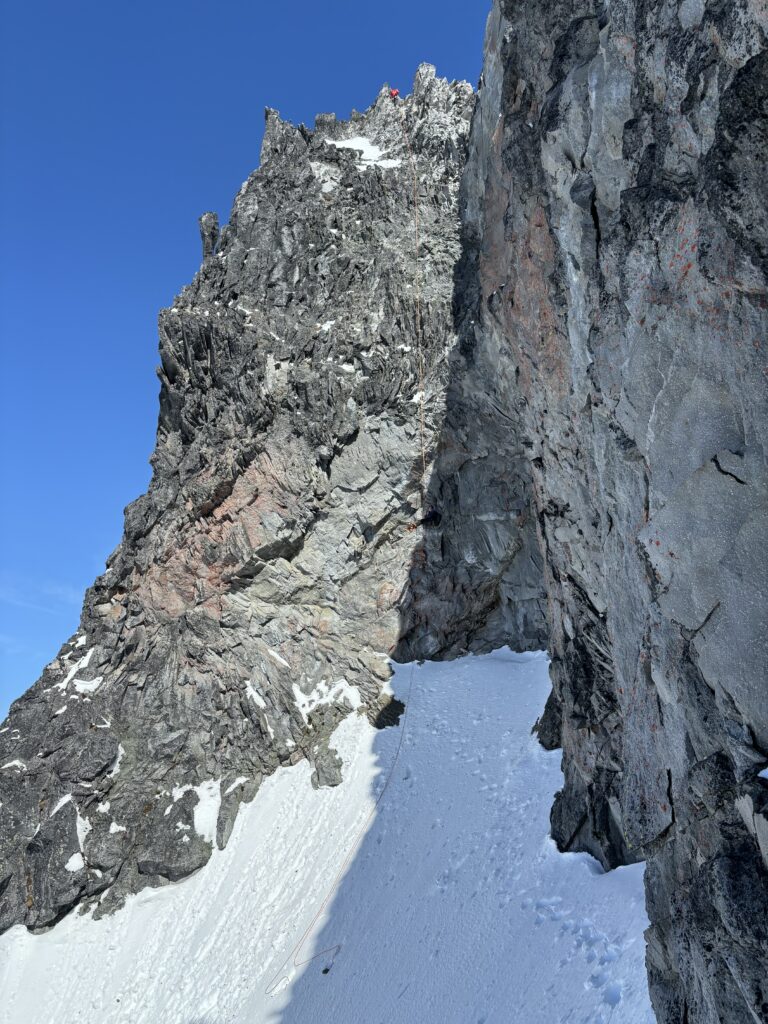
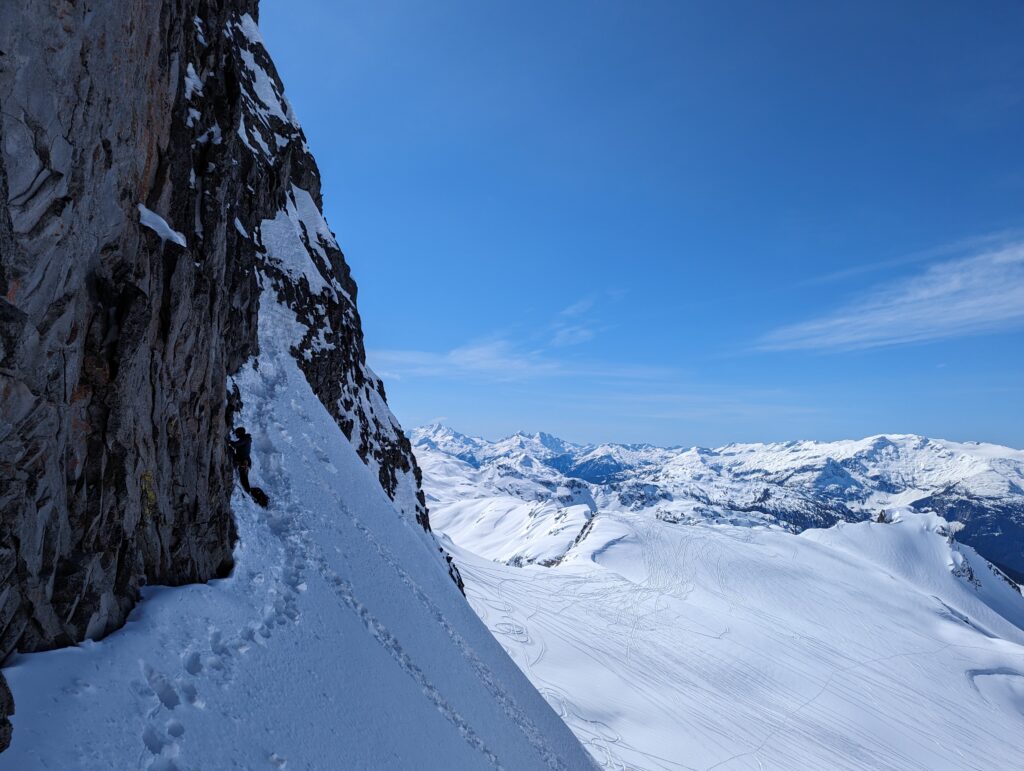
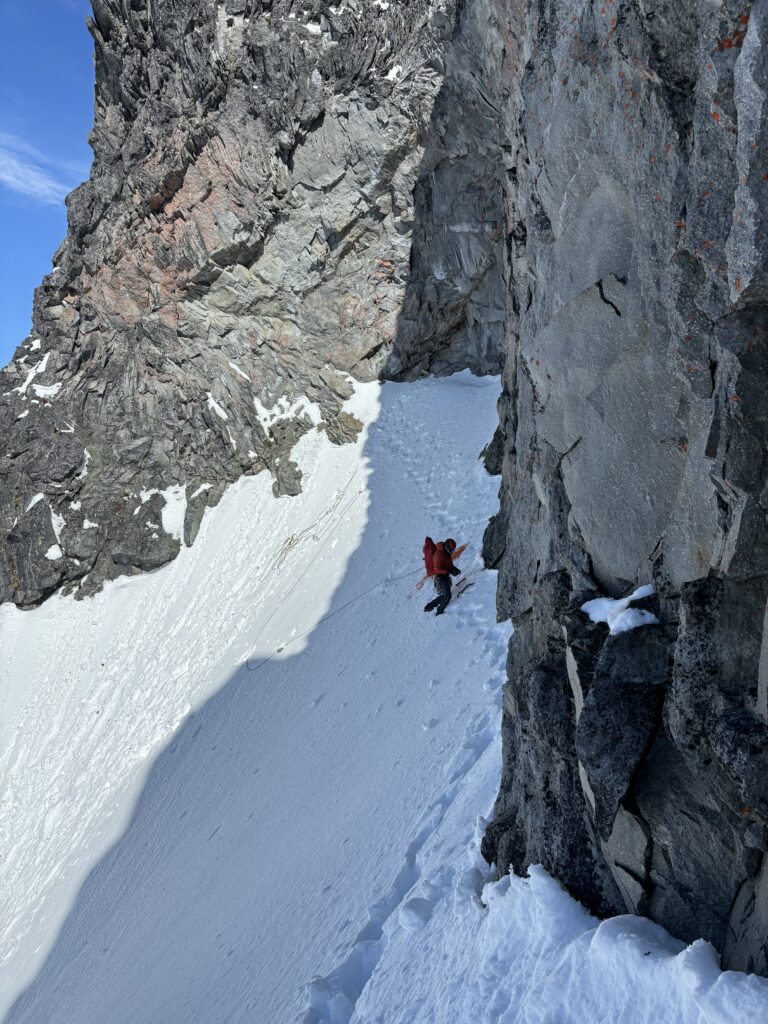
Descending through the crown proved to be not all that difficult thanks to the bucket steps we had set on the way up. I traversed back underneath Alessandro as he was finishing his rappel and he dropped the rope down to me so that he could more quickly get off the slope. We all reached the safety of our gear stash shortly after! In the end the snow had not deteriorated to a sketchy point yet, but we didn’t want to take any chances.
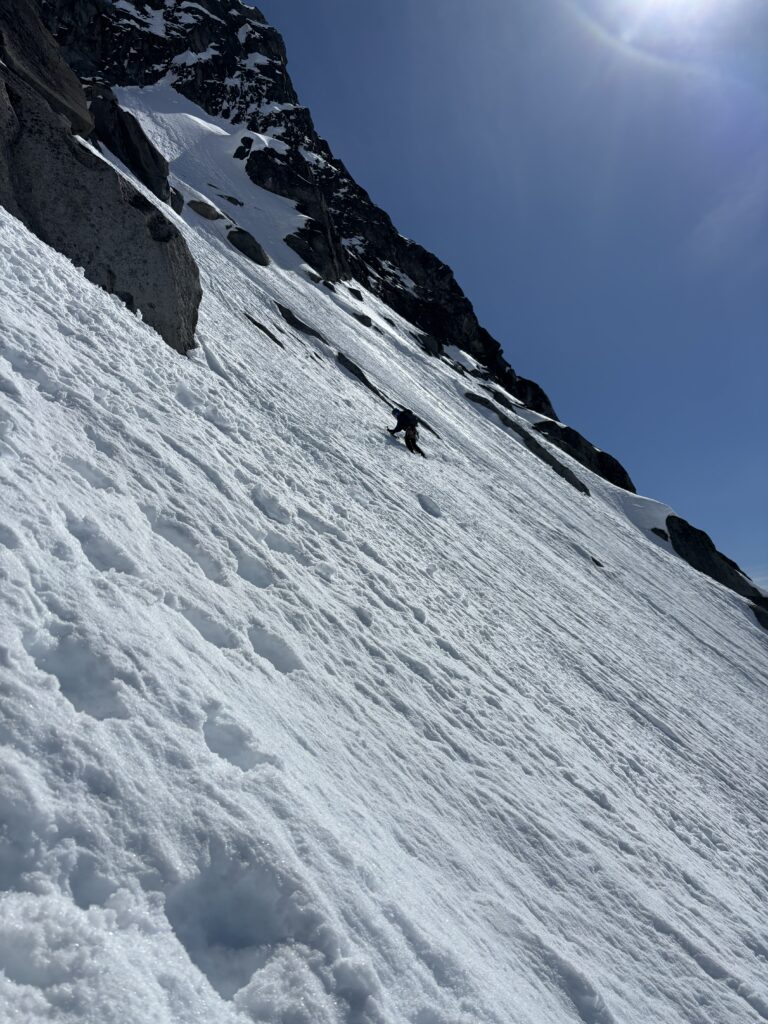
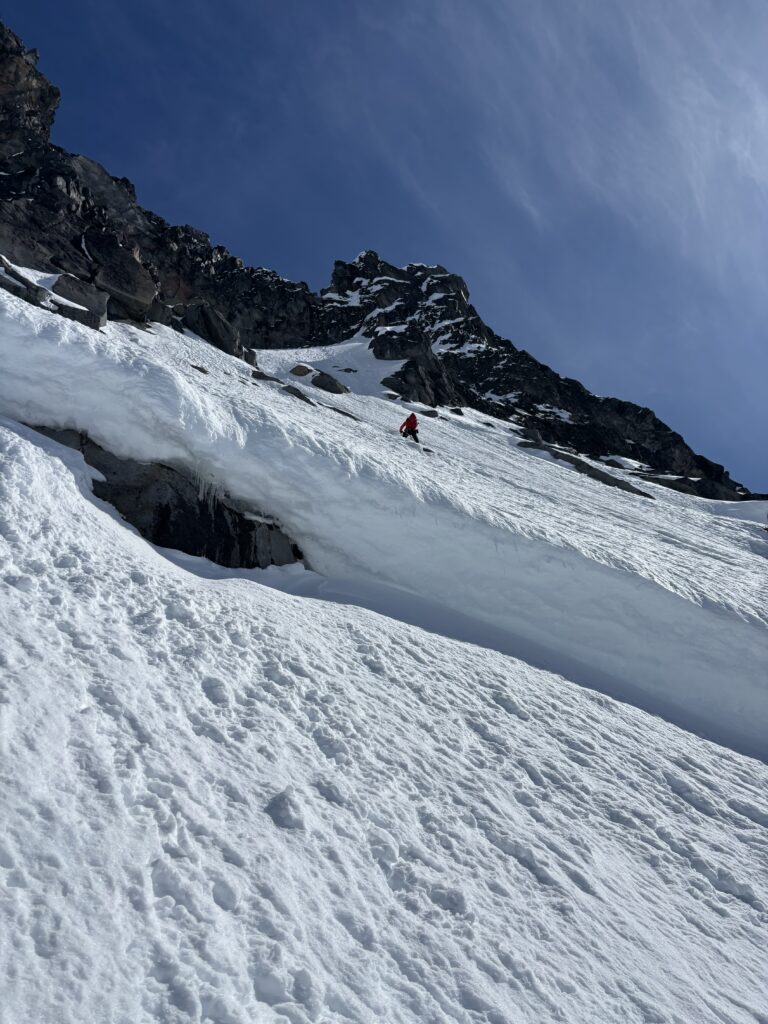
We spent about 30 minutes decompressing and getting some food before it was time to get going. Our plan was to traverse up to the ridge of Shovelnose Peak rather than take our exposed approach line back. This proved to be the right call and we avoided most of the steep sun-baked slopes by following a highway of snow mobile tracks. From there we reached our old tracks and took them back through the forest and out to the car. Alessandro whipped past us on skis and had some extra leisure time at the cut block while he waited for us. This proved to be full on day of adventure to say the least!
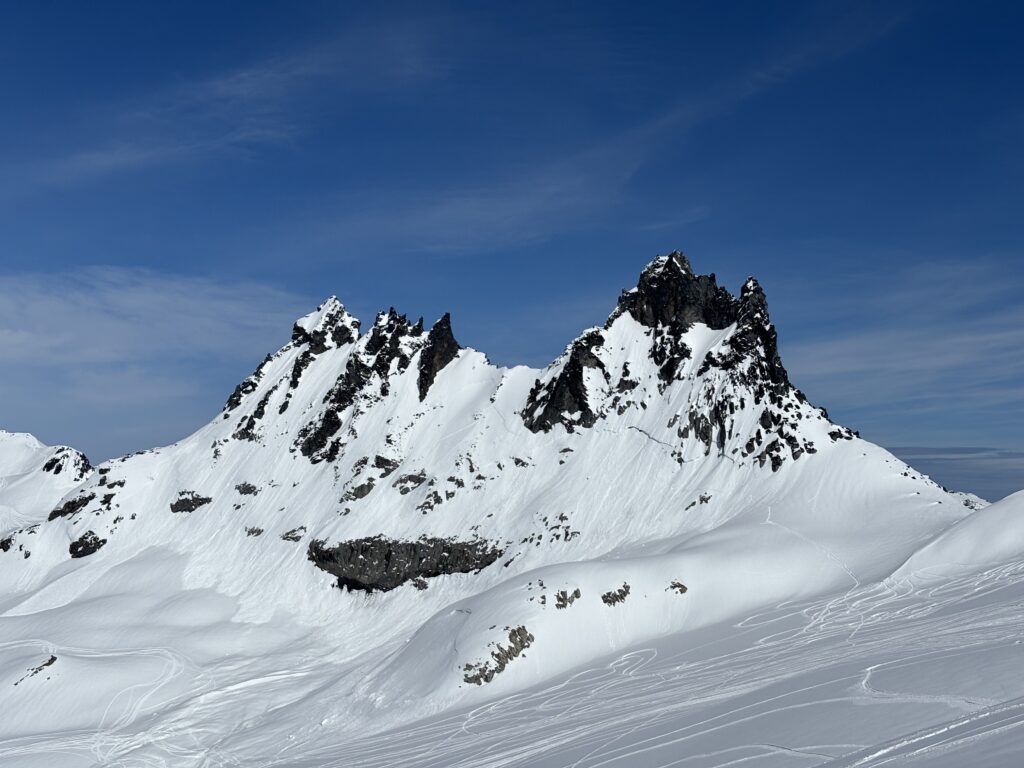
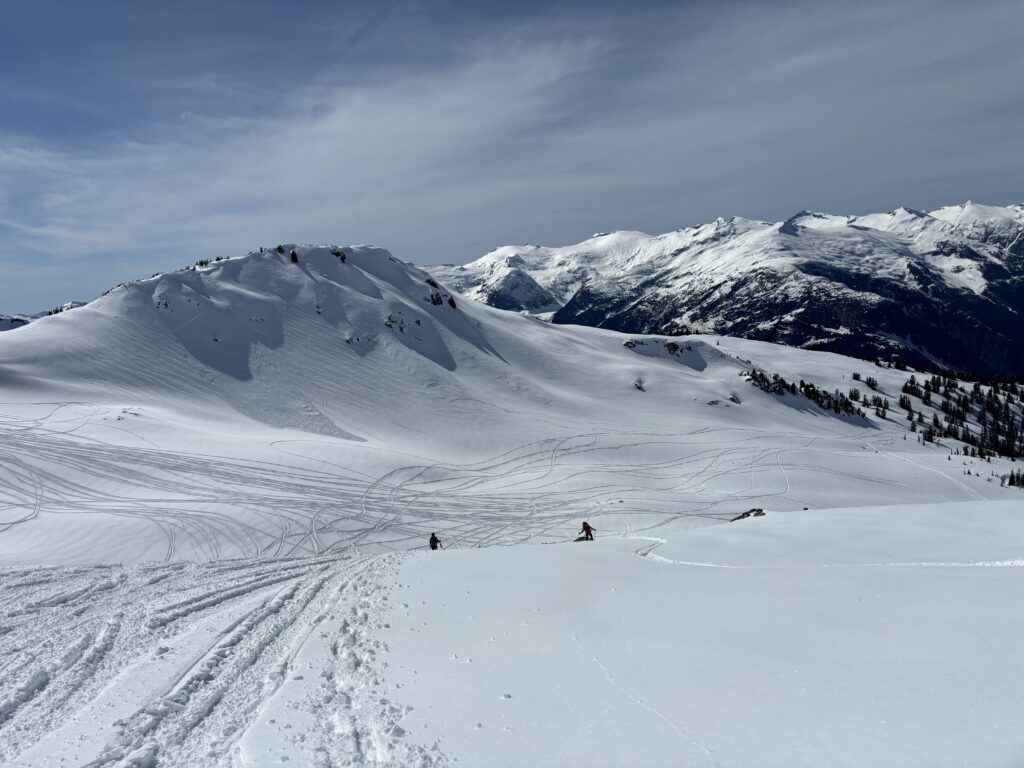
I think if not for the loose nature of the climb, this would be an exceptionally popular summit owing to the aesthetic knife edge ridge traverse and steep imposing nature of it all. Personally, I found the route about as loose as Mount Cayley‘s summit pinnacle, but much more sustained and exposed. Protection was mostly decor as what cracks there are, are usually formed by loose blocks that are about to calve off. I felt the 5.6 grade was on point. The extra snow on the ridge and loose nature of the climb certainly stiffened up the mental grade for us on this occasion though. My hats of the first ascensionists. How they banged a piton into such a precarious position on the ridge is beyond me!
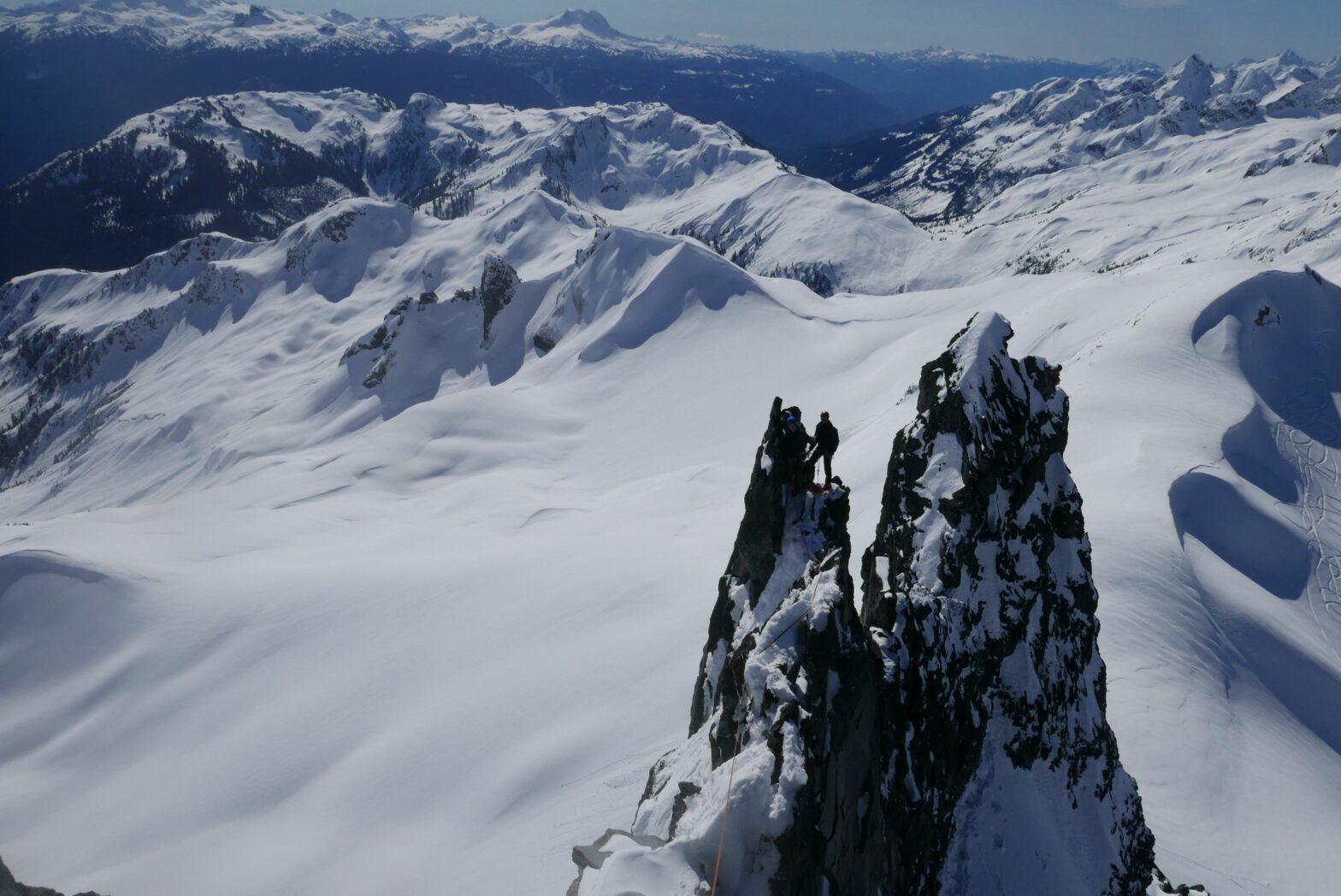
Congrats. I will pass this on to Bob and Peter (Mike is no longer with us….). It looks as if you had more snow than they did.
Thanks Glenn and yes I’d be curious if they happened to have any photos of their ascent!
Congrats on a fine climb!! As you are likely aware Harold Redekop and I made the first winter ascent back in 1985. I had attempted a winter ascent earlier with Phil Kubik using the route shown in my guidebook but we did not make it to the ridge because I could not climb the iced up vertical section (which I believe the first ascent partied aided) and we got too cold to continue. When Harold and I went back I just led straight up the wall from the highest snow, which sounds like where you folks went. The climbing was not too bad because ice held the rock together and I only used a couple of slings for pro. Likewise on the ridge we only used a few slings as pro as I recall and after summiting we down climbed to the point where we had gained the ridge and did one rappel to the snow. Harold and I climbed pretty efficiently as a team back then and think of this as one of my better winter efforts from that era. I will have to see if I can dig up my old photos of the climb to compare with the great photos you have posted. Harold is showing up at my door for a bit of rock climbing in a couple of days and I’ll be sure to show him your account!